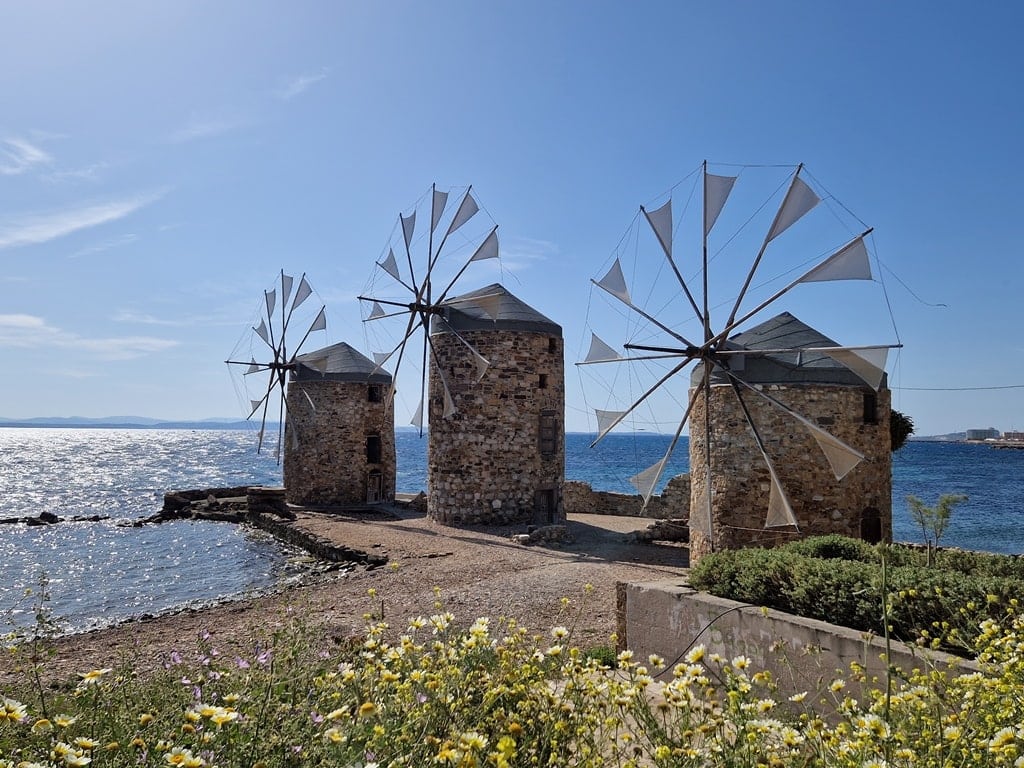A place you won’t find anywhere else in the world and which can’t be replicated is the historical and natural wonder of the island of Chios.
Chios is more than just a gem of the Eastern Aegean and the only place where mastic trees produce the world-renowned mastic: it is incredibly picturesque, with gorgeous villages, breathtaking views, and emerald waters just a tiny bit away from the shores of Asia Minor.
If you’re looking for an unprecedented experience in the Greek islands, then Chios should be at the top of your list. This guide will help you design your vacations and make the most of your visit to one of Greece’s most culturally and historically rich islands with stunning natural beauty.
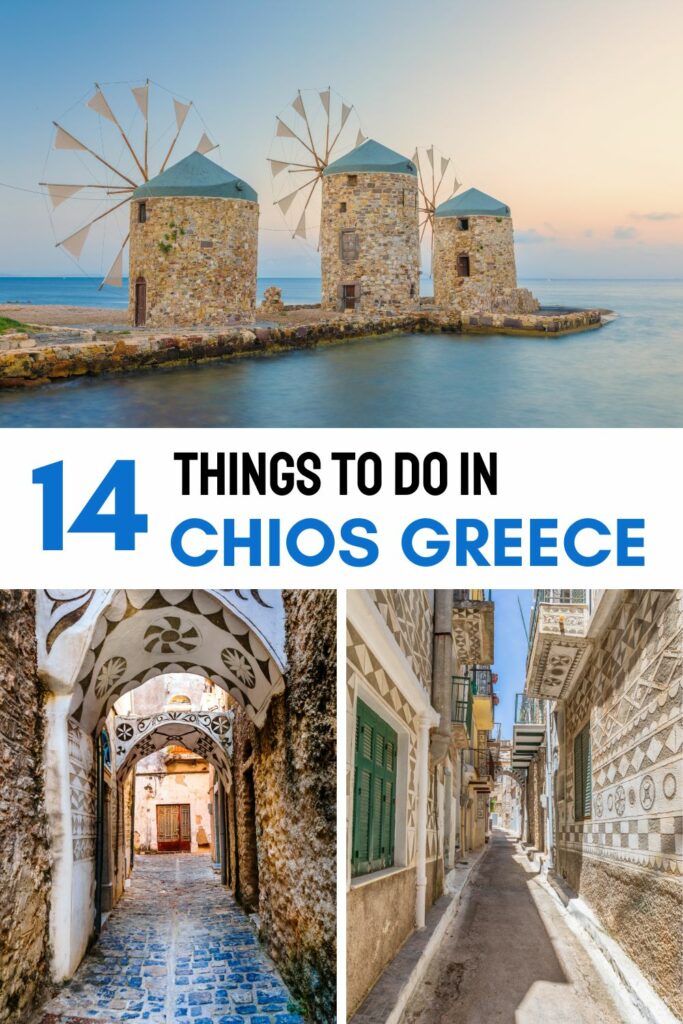
Disclaimer: This post contains affiliate links. This means that I will receive a small commission if you click on certain links and then purchase a product.
- Where is Chios?
- How to get to Chios
- How to Get Around Chios
- A Brief History of Chios Island
- Things to Do in Chios
- Explore Chios’ Chora
- Visit the Museums
- Visit the Archaeological Sites
- See the churches and monasteries
- Explore the mastic villages (Mastichohoria)
- Visit historic villages
- See the caves
- Relax with a soak in the thermal baths of Agiasmata
- Visit the villages of Kampos and the Museum of Citrus Fruits
- Hit the beaches
- Take a day trip to Oinousses island
- Take a day trip to Çeşme and Izmir, Turkey
- Visit Ariousios Winery
- Check out Chios’ beer
Where is Chios?
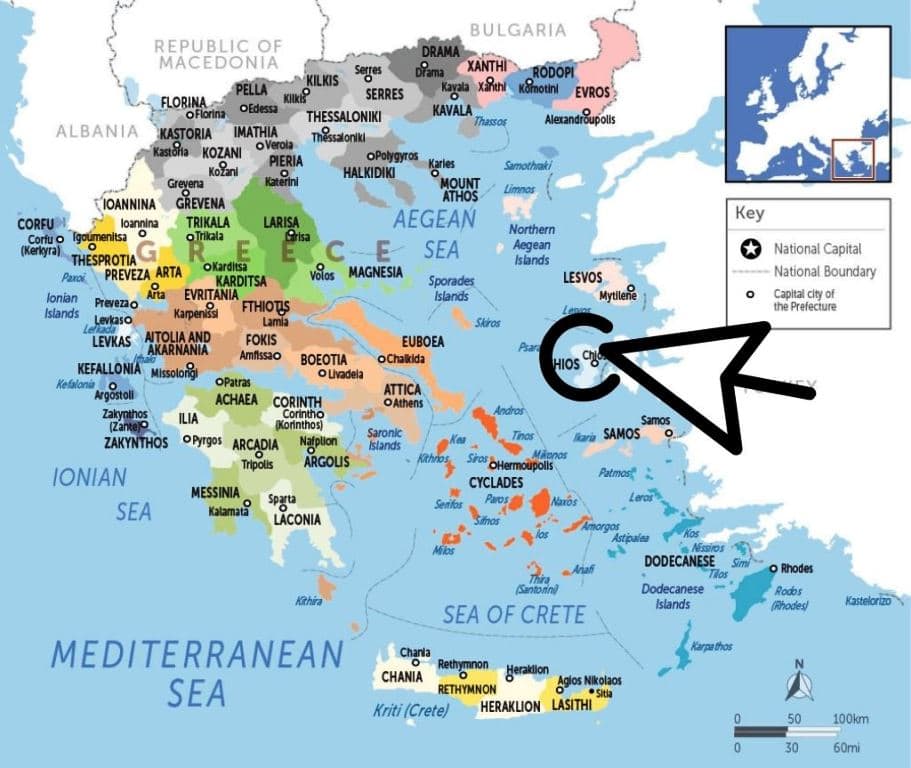
Chios Island is situated in the North-Eastern Aegean, just 15 km from the coast of Asia Minor and Turkey. It is the fifth-largest of the Aegean islands. Chios is gorgeous both in terms of its nature and its culture and the general ambiance of a profoundly historical and artistic environment.
Like all of Greece, Chios’ climate is Mediterranean. That means hot, dry summers and relatively mild, humid winters. Temperatures can climb to 35-38 degrees Celsius during summer and drop as low as 0-5 degrees Celsius during winter. However, temperatures can go up to 40 degrees when there are heatwaves.
The best season to visit Chios is from May to late September, the summer period. September has the asset of better prices and more mellow heat as it is the end of summer.
How to get to Chios
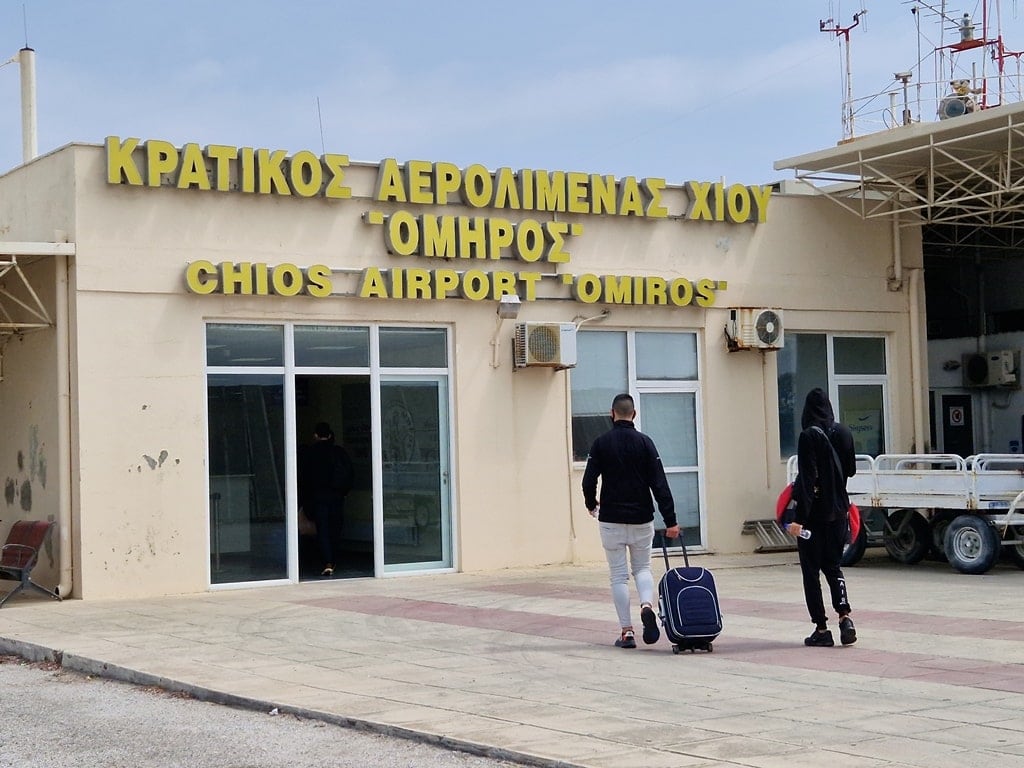
There are two options for traveling to Chios: by ferry or plane.
To travel to Chios by ferry, you need to land in Athens and go to Piraeus port. The trip from Piraeus to Chios lasts roughly 8 hours so consider booking yourself a cabin.
Chios is also connected by ferry to several other ports, such as the port of Kavala in the north, as well as several ports in the Cyclades, like Mykonos and Syros. Before you decide on island hopping from the Cyclades to Chios, make sure you check the time it takes to get you there by ferry!
Click here to check the ferry schedule and book your tickets.
Or enter your destination below:
If you want to invest in minimizing the travel time, you can fly to Chios. You can fly to Chios from Athens airport and Thessaloniki.
The flight from Athens to Chios is roughly an hour, often less than that. The flight from Thessaloniki to Chios is just over an hour.
You can compare flights from Athens to Paros on Skyscanner.
How to Get Around Chios
Chios is one of the biggest islands in Greece. There is a public bus (ktel) that you can use to get around the island, but renting a car is the best way to explore.
I recommend booking a car through Discover Cars, where you can compare all rental car agencies’ prices and cancel or modify your booking for free. They also guarantee the best price. Click here for more information and to check the latest prices.
A Brief History of Chios Island
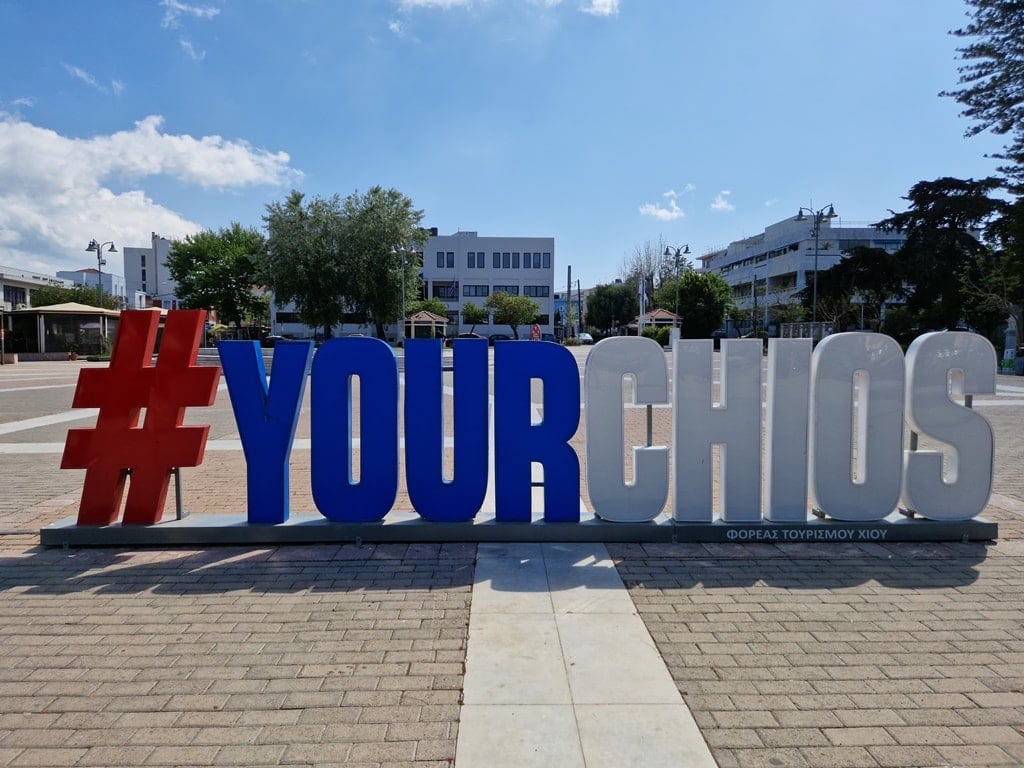
According to Pausanias, Chios received its name from the son of Poseidon, Chios, whom Poseidon had with a local nymph. Chios was born during a snowfall, and thus his name means “of snow.” He later gave his name to the island. Other names for Chios include “Ophioussa” which means “land of snakes” and “Pytioussa” which means “land of pines.”
Chios was inhabited at least since the Neolithic period. During the Archaic period, Chios was one of the first city-states to mint coins and later developed a democratic system similar to Athens’s. Chios became a naval power after it was liberated from Persian rule, initially joining the Athenian Alliance but later successfully rebelled and was independent until the rise of the Macedonian empire.
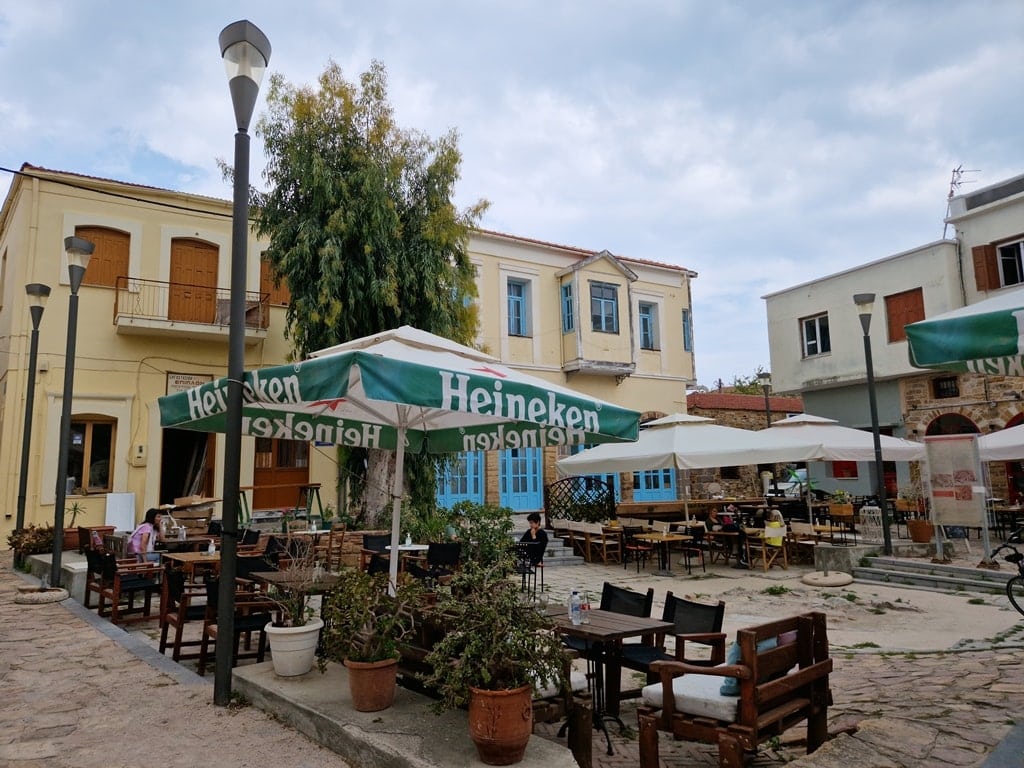
During medieval times, Chios was part of the Byzantine Empire until the 1200s, when it briefly came under the rule of the Venetians before becoming part of the Republic of Genoa. Finally, in 1566 Chios was conquered by the Ottoman Empire.
During the Greek War of Independence, Chios joined but was almost immediately sacked by the Ottomans in the now-famous Massacre of Chios. The Massacre of Chios shocked the West and inspired famous paintings like Delacroix’s. Chios remained under Ottoman rule until 1912 when finally it became part of the Greek state.
Things to Do in Chios
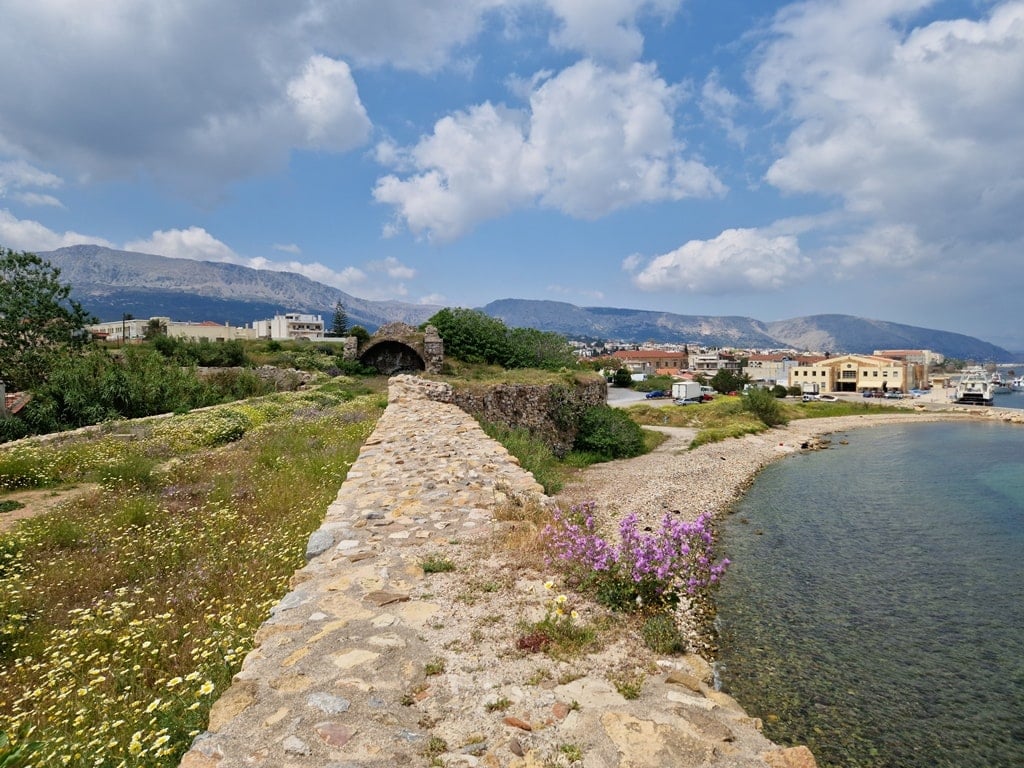
There are so many things to see and do in Chios that you may need to visit again! Chios has a lot more for you to enjoy than simply gorgeous beaches and beautiful natural landscapes.
There are villages that feel like time capsules with wondrous, unique architectural blends; there are renowned mastic villages, excellent museums, and haunting places where the impact of history is imprinted in the stone. Here are the places and activities that should be on your must-see list!
Explore Chios’ Chora
Situated on the island’s eastern side is the gorgeous Chios’ Chora. It is the biggest town in Chios and one of the most beautiful, with several sites and locations to visit.
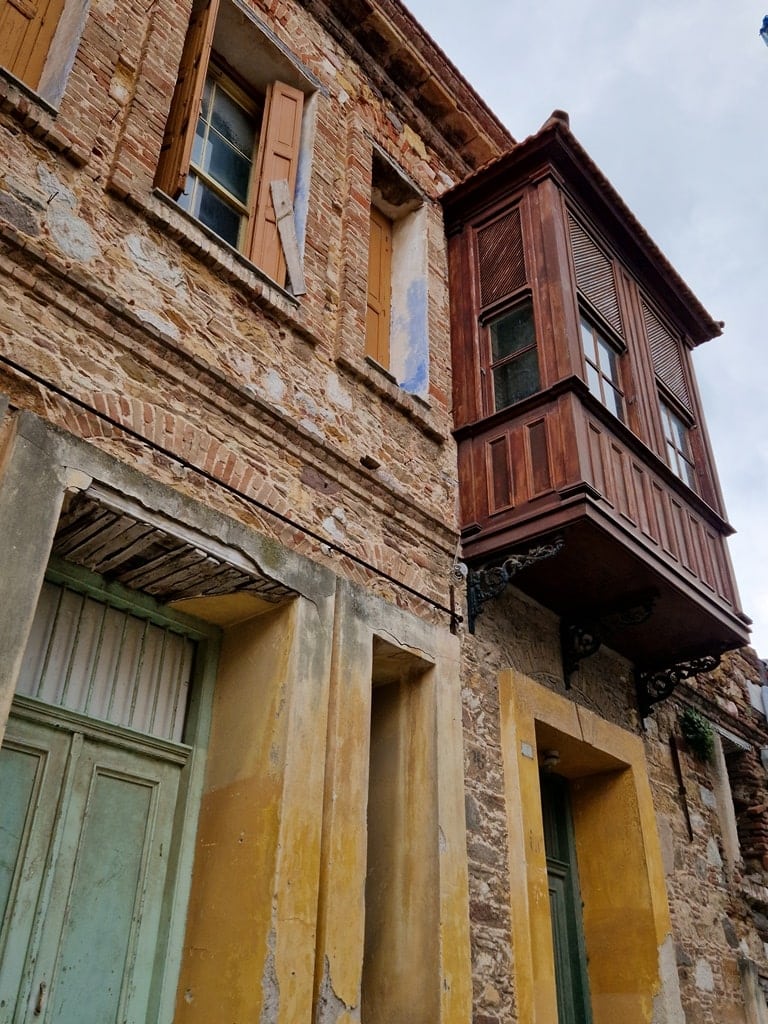
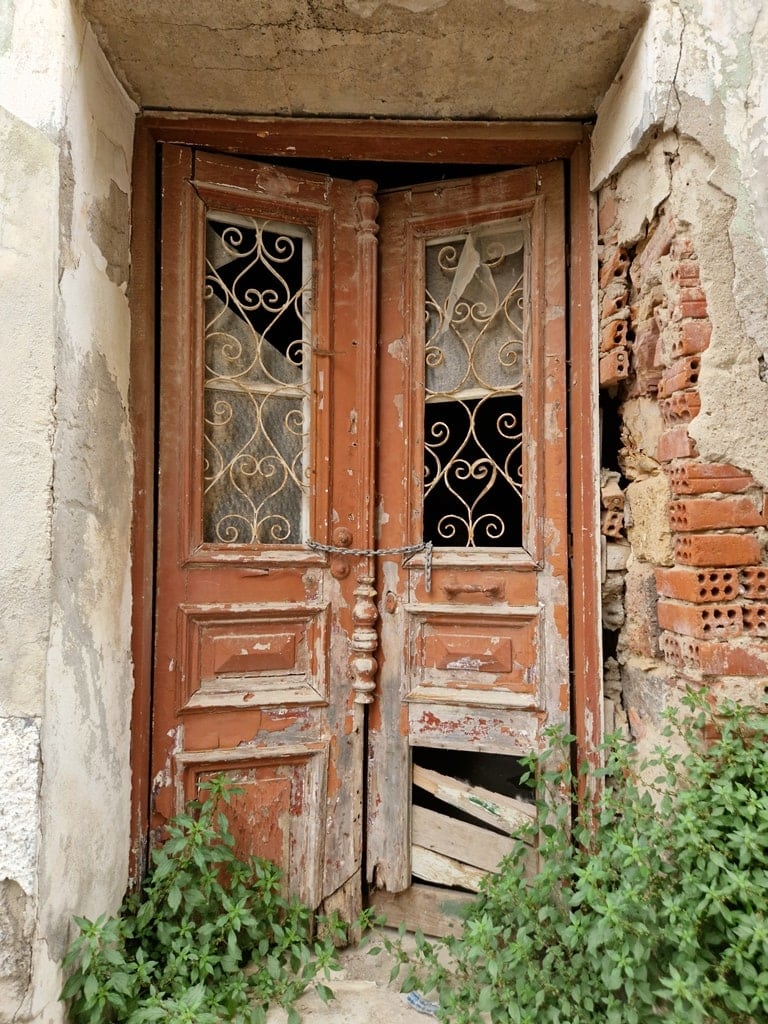
Though you can use a car, make it a point to walk around the city streets and admire several landmarks from various historical eras, such as the old Ottoman fountains, which have beautiful marble carvings, and the town square with the gorgeous blend of palm trees and marble, the vibrant waterfront with a lot of places to eat or have refreshments while enjoying the view of the Turkish shores over the waters, and more.
Beyond the sheer beauty of the town itself, there are a lot of landmarks and sights to visit:
Visit the Windmills of Chios
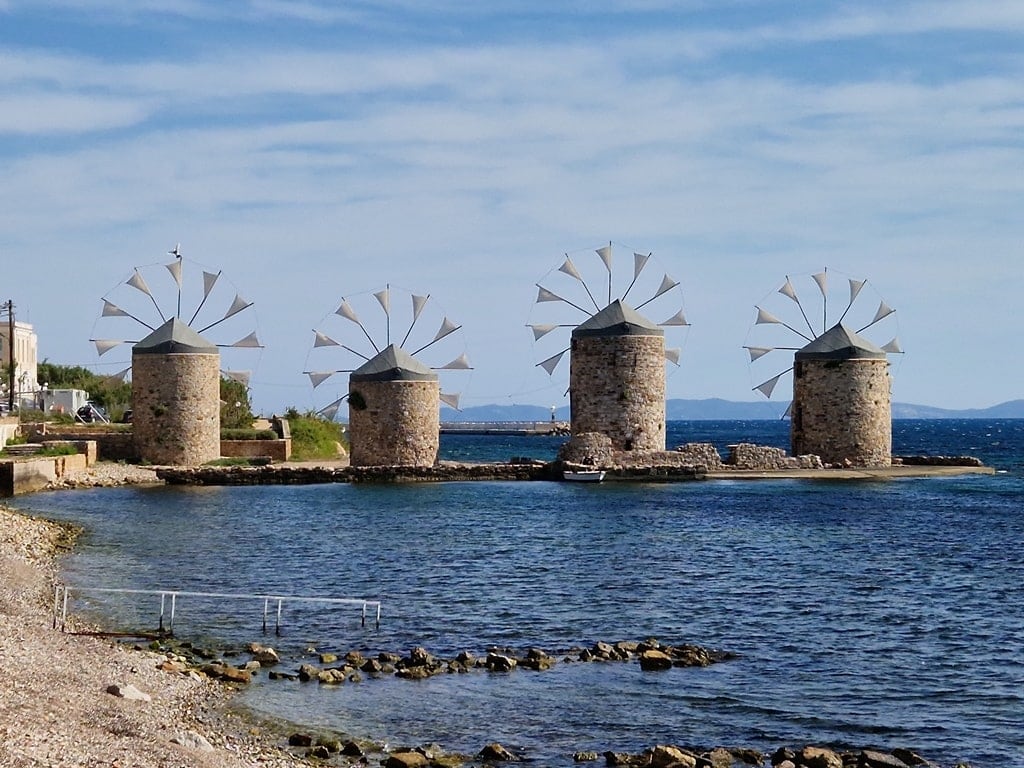
A little over 1 km from the center of Chios’ Chora, you will find the four windmills of Chios (though the locals call them ‘the three mills’). The area is called Tambakika and is part of the old industrial part of Chios.
The windmills are 10 meters high and were built in the late 19th century. They used to serve the needs of the tanneries surrounding them. They are remarkably well preserved, made of beautiful stone that contrasts greatly with the deep blue sea. It’s a perfect place for photos!
Visit the Castle of Chios
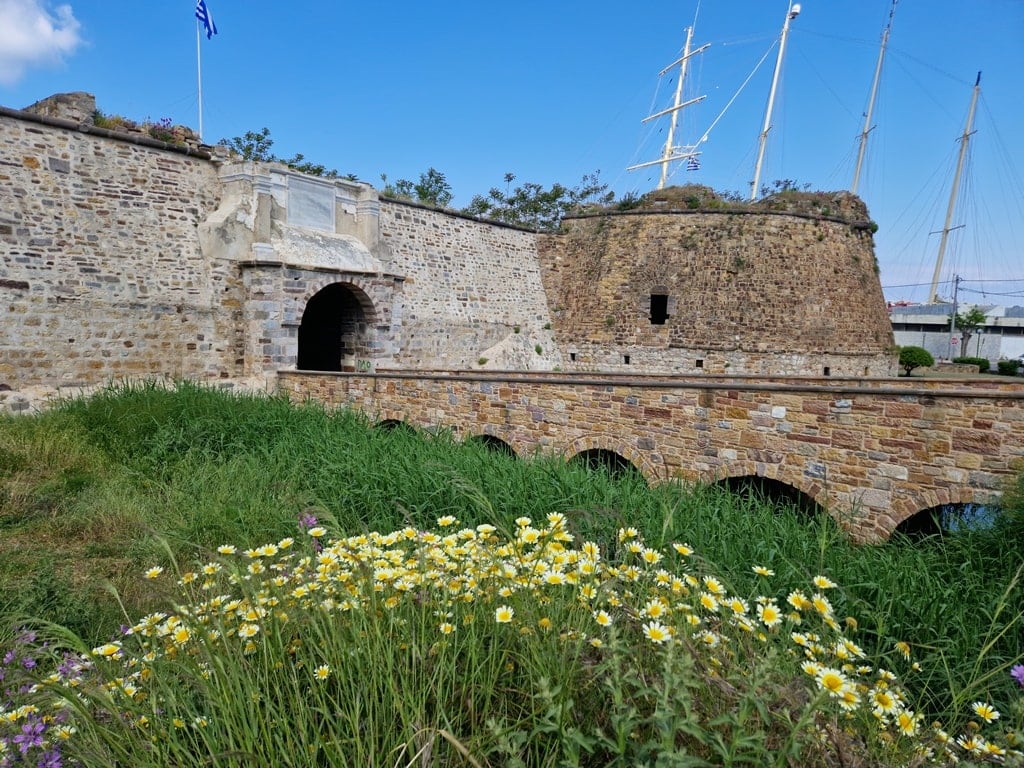
Right next to the main port of Chios, you will find its Castle. The Byzantines made it in the 10th century and later expanded further by the Genoese in the 16th century. Walk to Chios Chora’s main square and then follow Kennedy Street to reach the Castle’s main gate, called the Porta Maggiore.
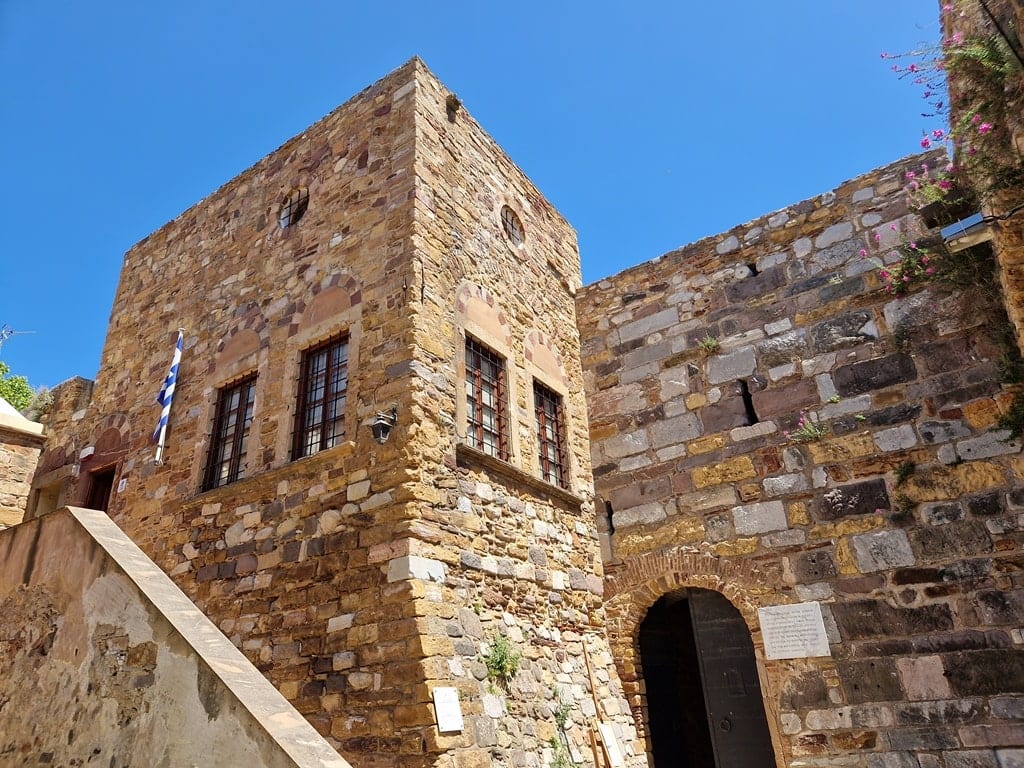
The castle has continuously been inhabited since it was made, so you can enjoy walking around its narrow streets and looking at various buildings built during different eras in the castle’s life.
Aghios Georgios Church: Follow the castle’s main street to reach the church of Aghios Georgios. Originally a Byzantine church, it was converted into a Genoese one and renamed San Domenico during the Genoese rule.
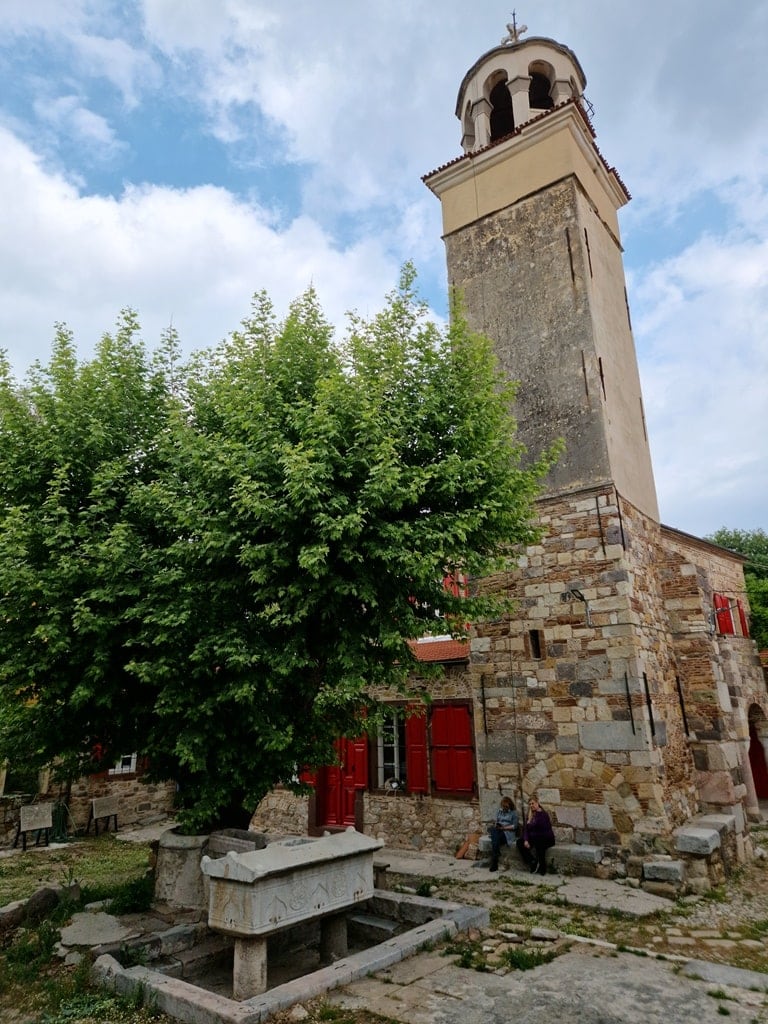
Inside the church is buried a prominent Genoese captain. The church is currently back to its original Aghios Georgios dedication.
The Turkish Baths: In the north area of the Castle, you will find the Turkish Baths. They are an 18th-century beautiful building of 10 rooms. Each room has a beautiful dome adding height with lighting holes in different shapes.
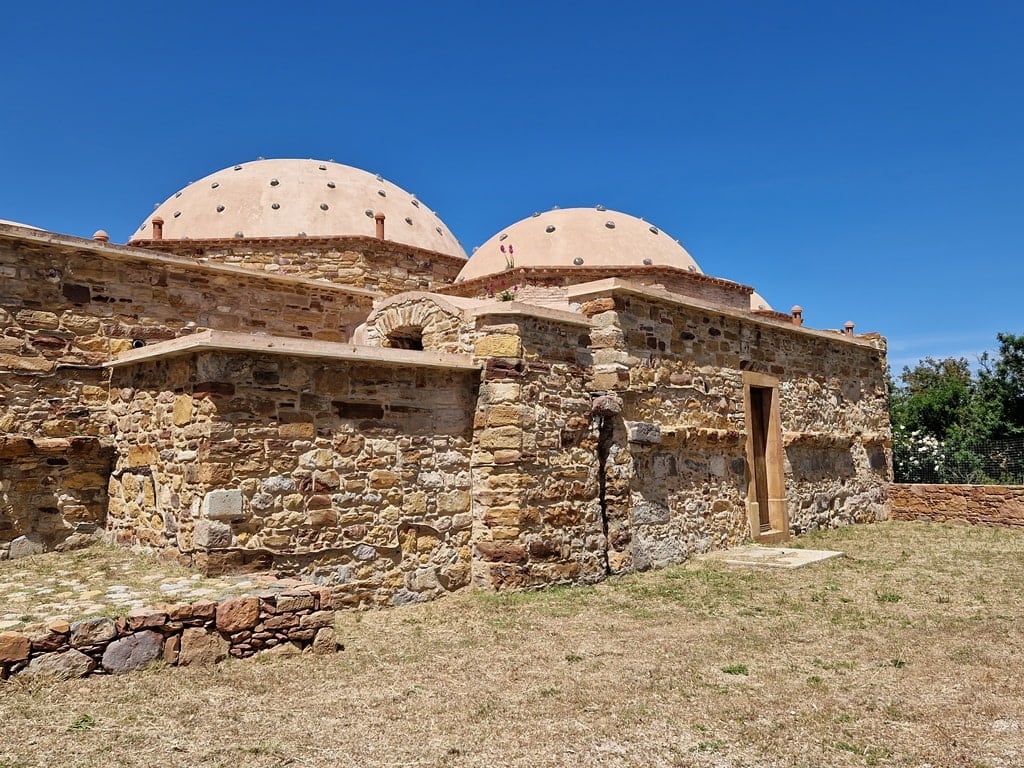
Walk around the hot room and feel the quiet tranquility as you observe the beautiful baths with tiled floors.
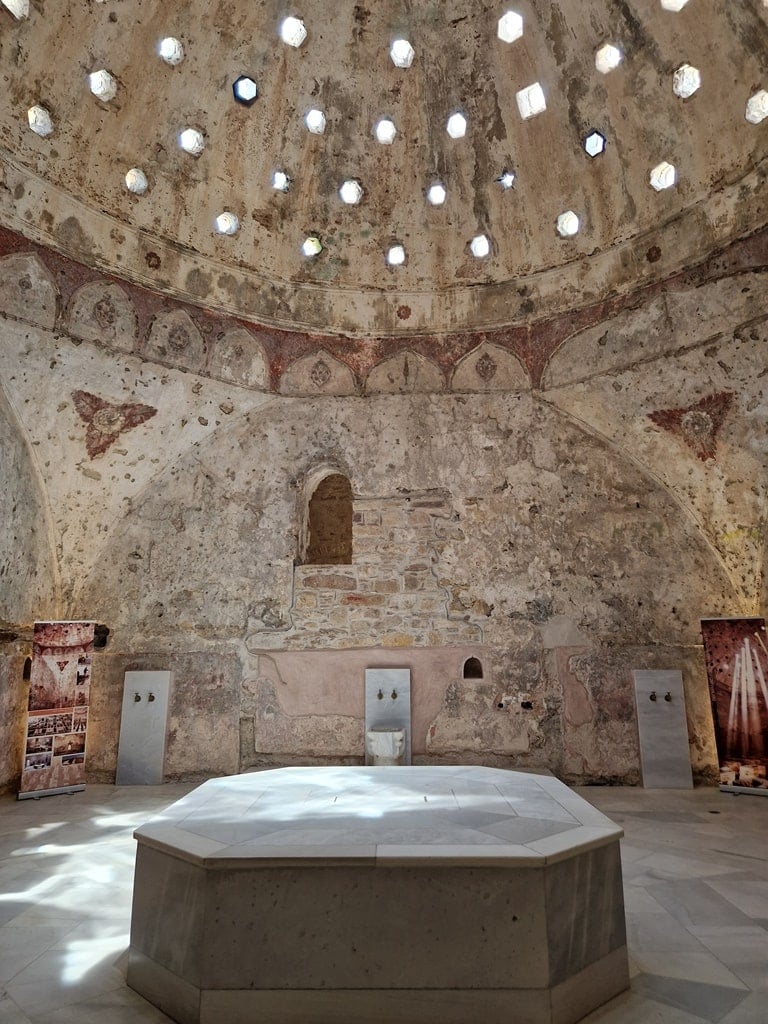
Visit the Museums
The Archaeological Museum of Chios: Near the center of Chios’ Chora is the Archeological Museum. You will see beautiful and plentiful artifacts of local people’s everyday life from the Neolithic period to modernity. You will also be treated to temporary exhibits, such as Minoan artifacts and beautiful gold jewelry from the era on the island of Psara.
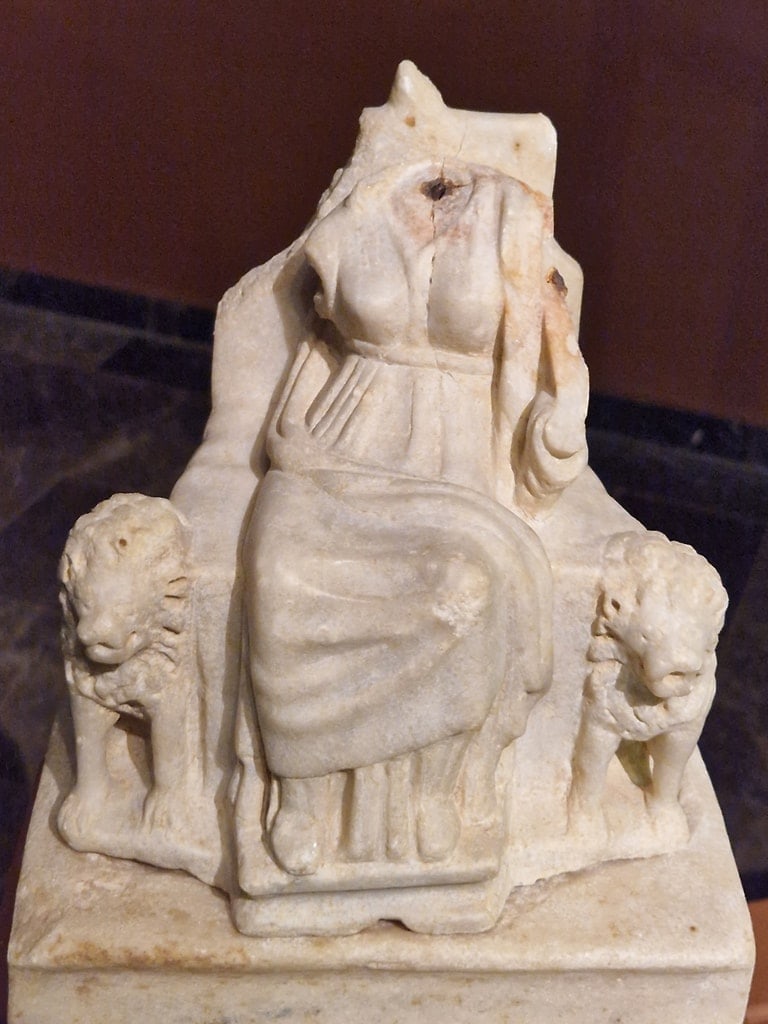
The Byzantine Museum of Chios: Housed in the Ottoman mosque of Metzitie, the exhibits within the historical edifice also serve to showcase the artistry of the mosque as well, which was built in the 19th century. The exhibits portray everyday life from the early Christian years to the 19th century, including the mosque itself in the experience.
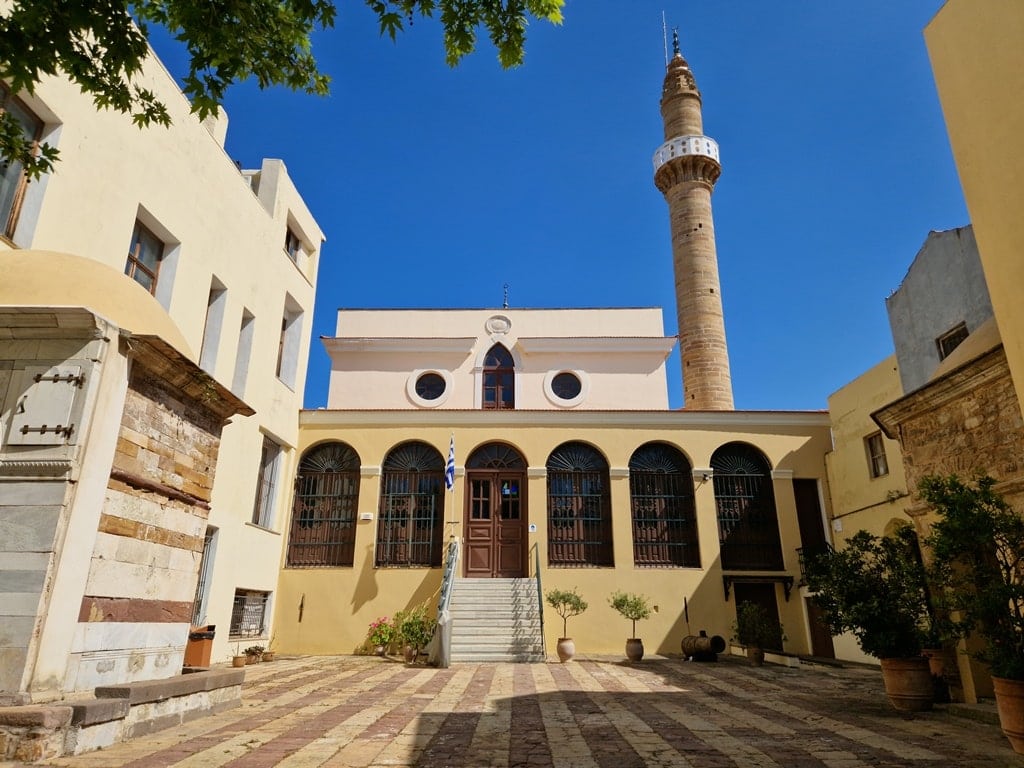
The Maritime Museum of Chios: In a beautiful neoclassical building at the center of town, you will find the remarkable Maritime Museum. As a significant naval power, Chios’ naval history is rich and on full display there, including ship replicas and parts and several artifacts connected with the maritime traditions of the island. Don’t forget to visit its garden with the imposing monument to Chios’ fallen seamen during WWII.
The Library of Korais: Right in the center of town, you will find the majestic Library of Korais, one of the oldest and most important libraries in Greece. It was founded in 1792, and its first books were brought by Adamantios Korais, one of the most prominent scholars of Greece, also part of the pre-revolutionary movement.
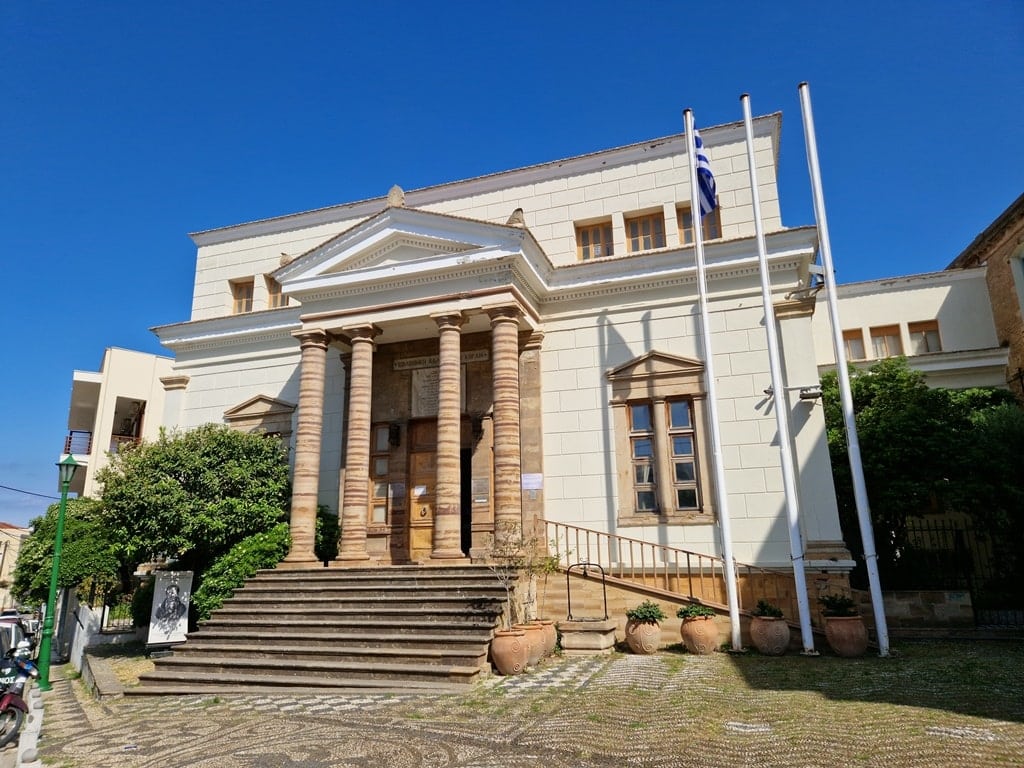
During the sacking of Chios in 1822, the library was destroyed, but Korais again worked to reconstruct it and resupply it with books. It holds priceless book collections and other artifacts such as manuscripts and coins, including a donation made by Napoleon Bonaparte himself.
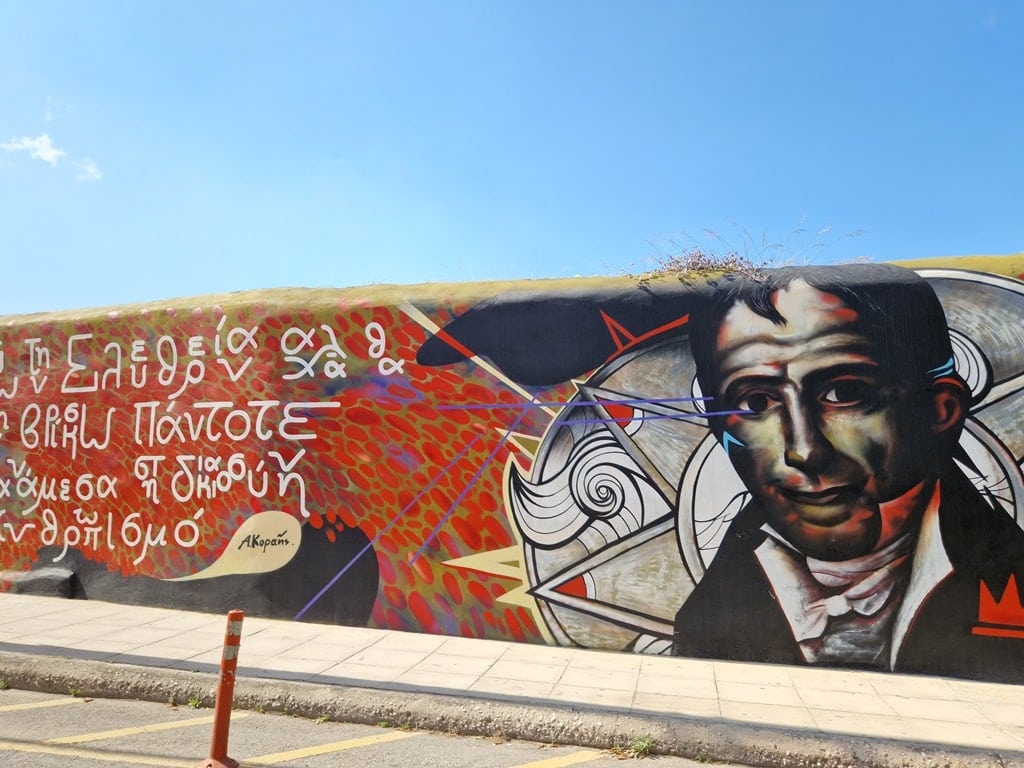
The Mastic Museum: You will find this museum in the Mastic Villages region in the south of Chios. Surrounded by mastic trees, the museum is dedicated to the history and process of cultivation and production of mastic (mastiha in Greek).
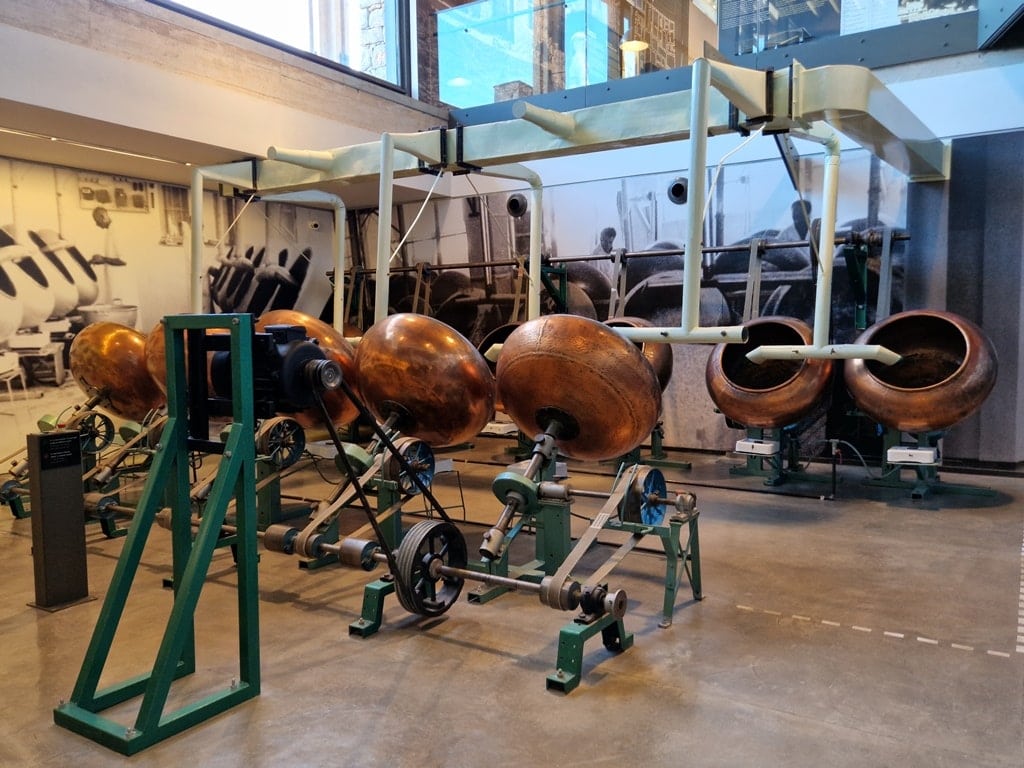
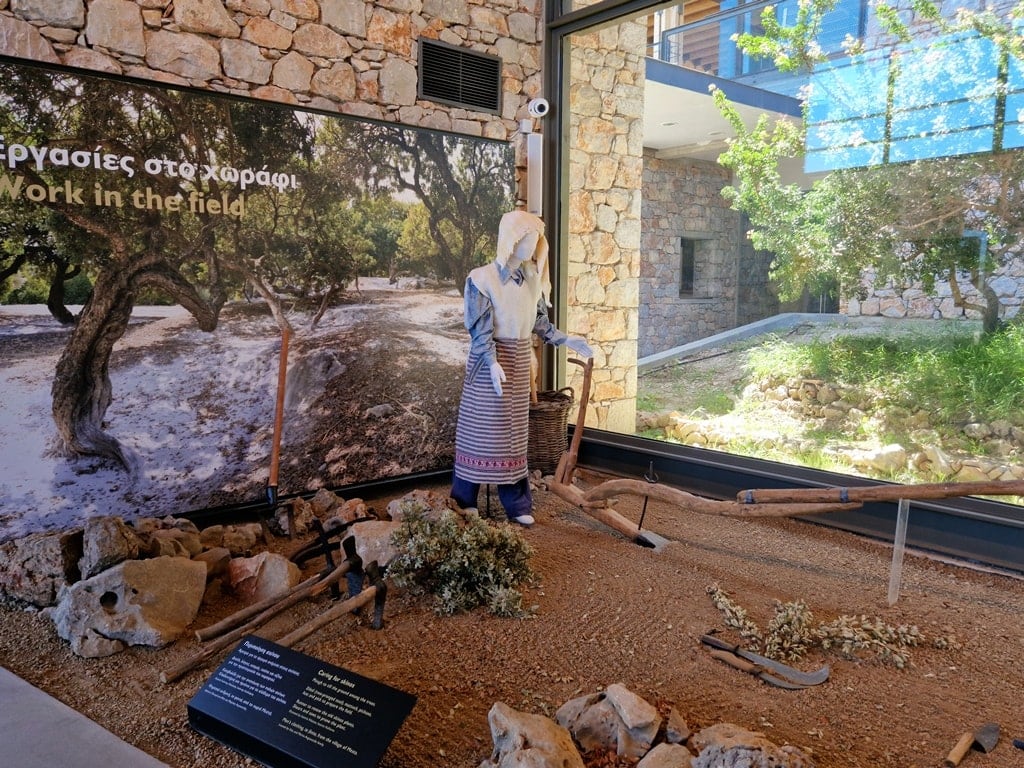
Enjoy the impressive exhibitions and the multimedia tours through Chios’ most remarkable product.
Visit the Archaeological Sites
Daskalopetra (Homer’s Stone): Near the village of Vrontados, you will find Daskalopetra, which means “the teacher’s stone.” According to tradition, that was the exact stone where Homer would sit to narrate his epic poems, the Iliad and the Odyssey. Besides the allure of the legend, walking to Daskalopetra will grant you great views of the sea, the village, and the surrounding area.

Temple of Athena at Emporio: The ruins of the temple of Athena are located on a lovely slope of Profiti Ilias hill, near the area of Emporios. The spot is perfect for a sweeping view of the Aegean. In good weather conditions, you will be able to see the islands of Samos and Ikaria! The sheer atmosphere of the area won’t disappoint you.
The archaeological site of Emporio: On the same slope of Profiti Ilias hill, you will find a settlement site that dates from the 8th century BC. It features an acropolis at least 50 houses, and another temple. Make sure to go at a time when the sun isn’t too scorching and admire the area and the breathtaking view.
Temple of Fanaios Apollo: At the quiet bay of Fana in a beautiful grove of olive trees, you will find the temple of Apollo. Legend has it that it was at this spot that Leto, Apollo’s and Artemis’ mother, was told she could give birth at Delos (hence the name, which means ‘to reveal’). Only parts of the temple remain today.
See the churches and monasteries
The Monastery of Aghia Markella: 8 km from Volissos and 45 km from Chios’ Chora you will find the monastery of Aghia Markella, the patron saint of Chios. The monastery is built right on the gorgeous beach, looking across the sea to the island of Psara. According to the lore, St. Markella was a devout Christian girl with a pagan father around the 14th century.
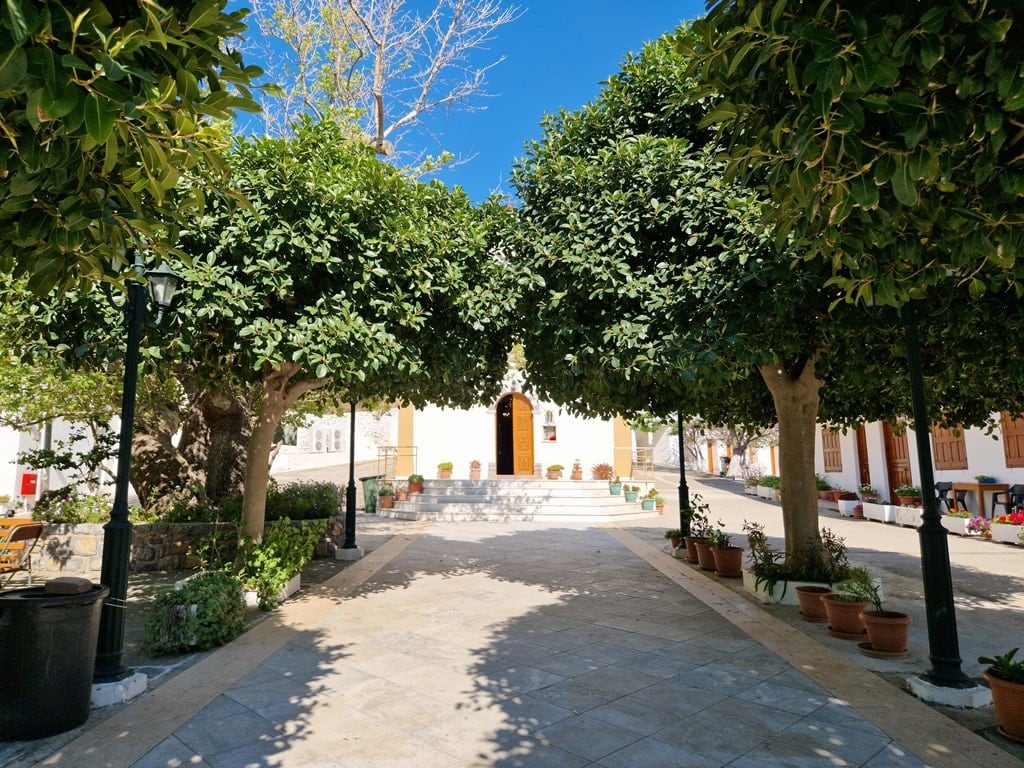
When her father tried to convert her, she ran away and tried to hide. However, her father found her and killed her, cutting her head and throwing it into the sea. It was at that site that water sprung up and still flows today. On the anniversary of her martyrdom, there is a big pilgrimage, and it is said that when the priest says her prayers, the sea boils and becomes extremely warm, turning the salty water into a fresh, drinkable one.
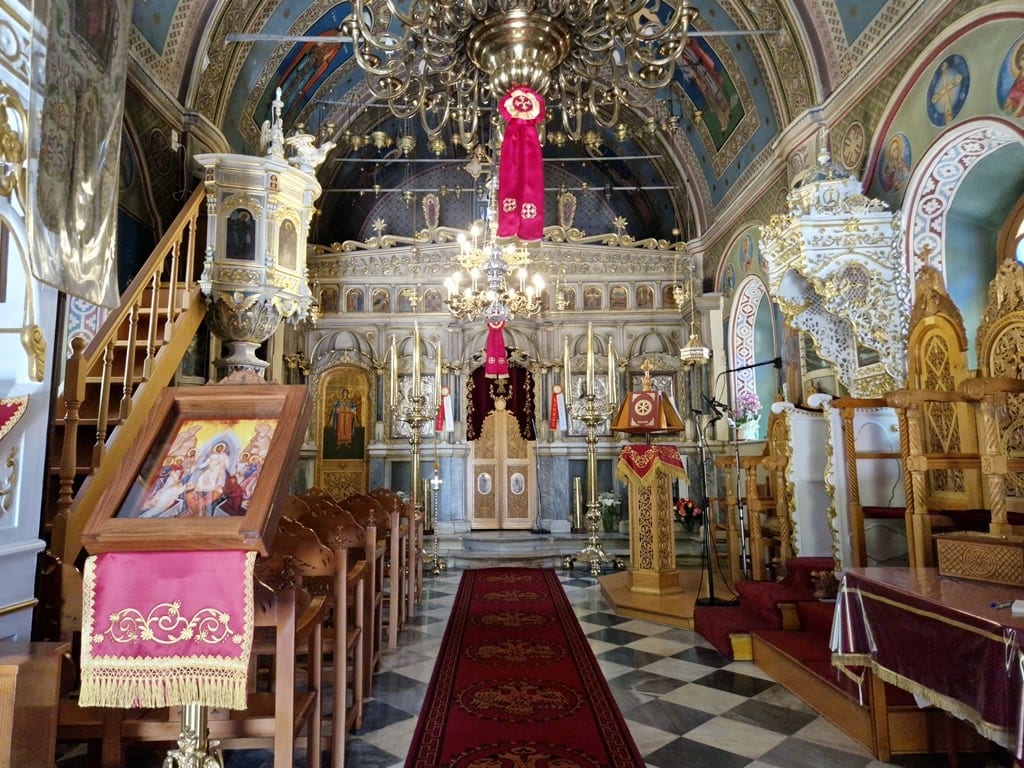
Visit the area for the stunning views, the atmospheric memorial, and the beautiful wild beach with black sand and unusually warm waters.
Nea Moni: 12 km from the center of Chios’ Chora, you will find the stunning monastery of Nea Moni, a recognized UNESCO World Heritage Site. The monastery was founded in 1042 and is renowned for its intricate, beautiful mosaics. These mosaics are said to be the peak of Byzantine “Macedonian Renaissance Art.”
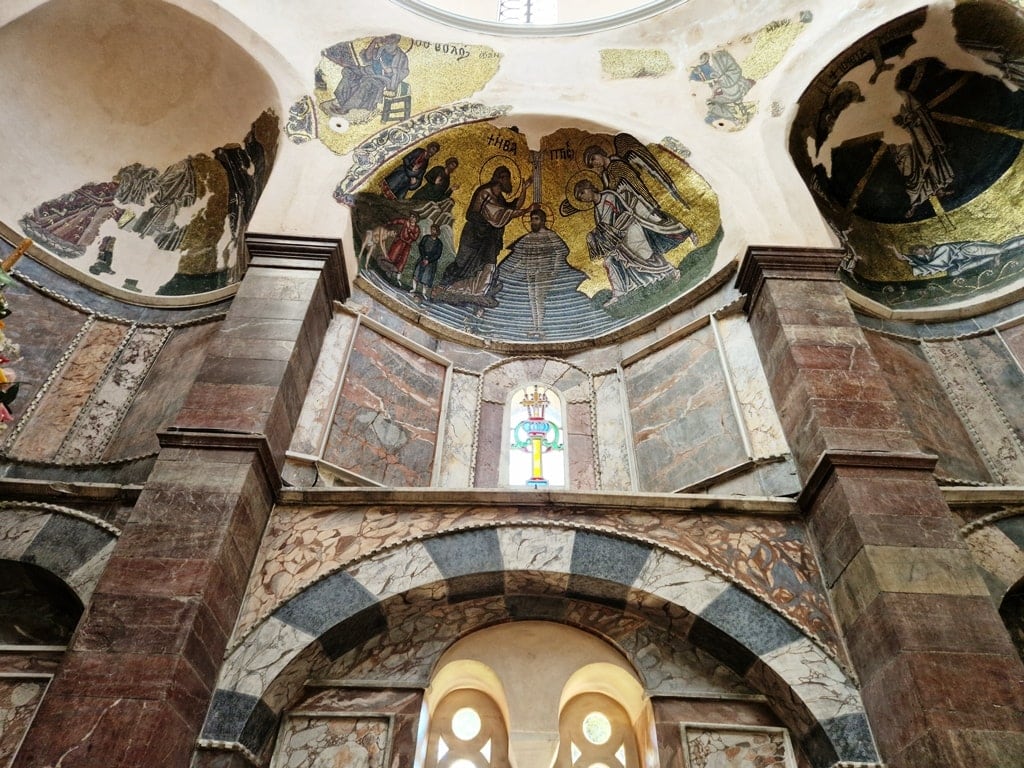
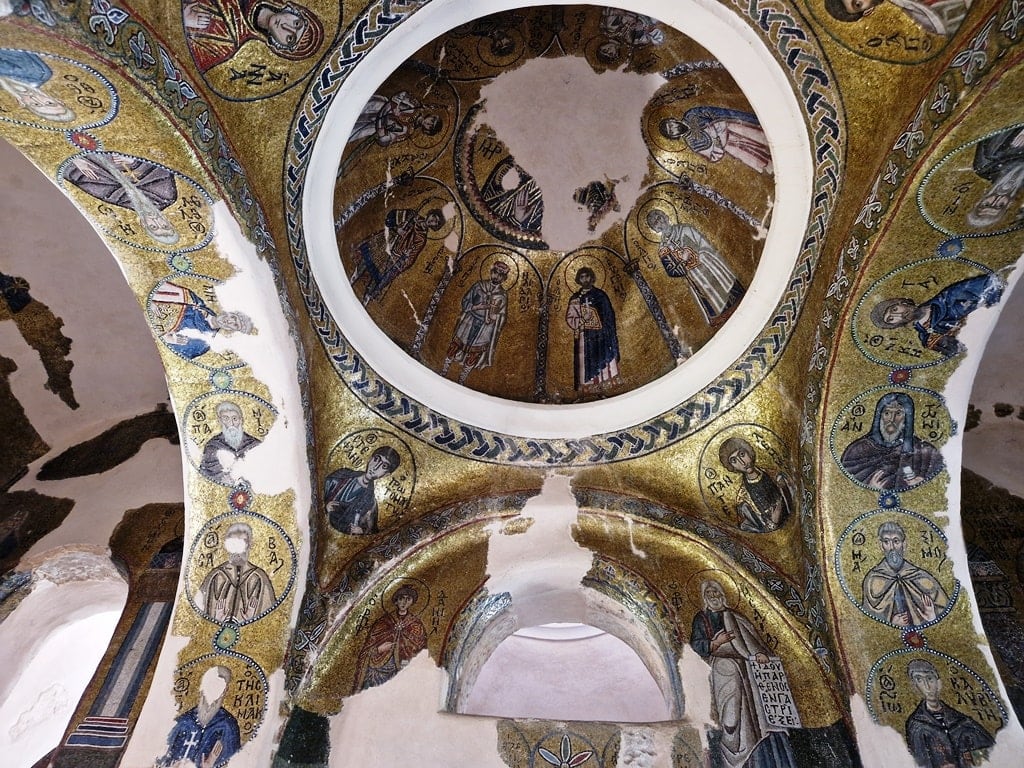
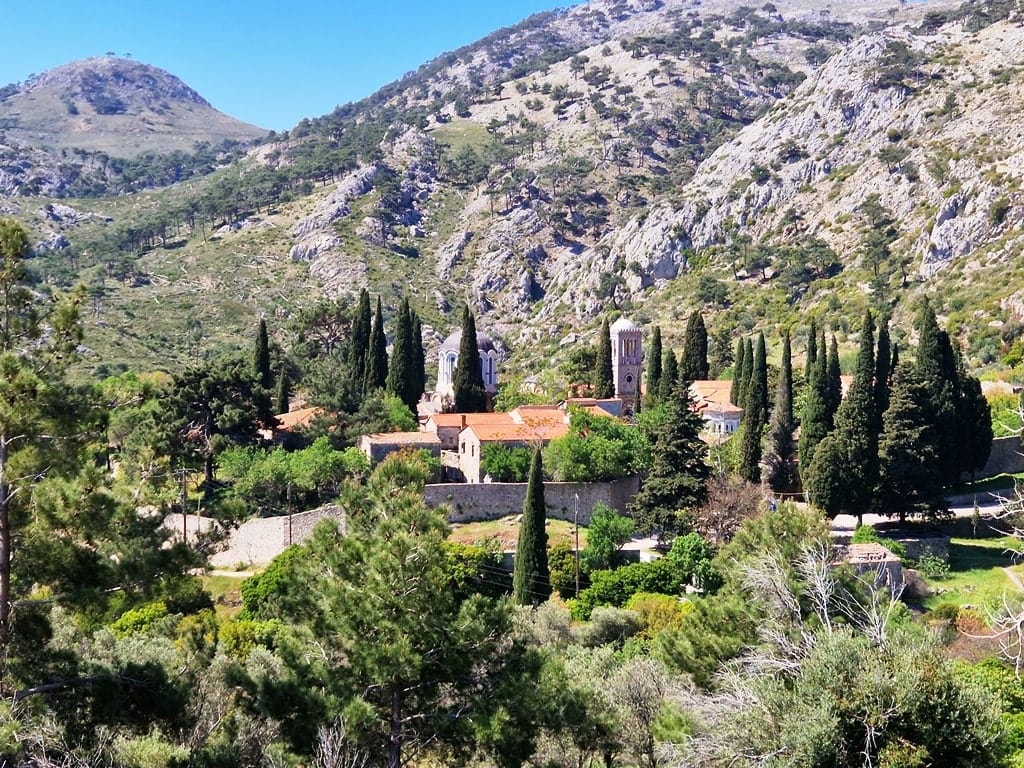
It was burned down and sacked during the Massacre of Chios but managed to preserve most of its artwork, and the sacred icon is housed. There is a chamber in the monastery’s cemetery area housing the bones of all those killed during the Massacre.
Chapel of Aghios Isidoros of Sykiada: The picturesque chapel of Aghios Isidoros of Sykiada is probably the most photographed site in all of Chios. Situated on a tiny islet connected to the rest of Chios by a thin corridor, this chapel was built in the 18th century in this atmospheric, beautiful location surrounded by stone and sea.
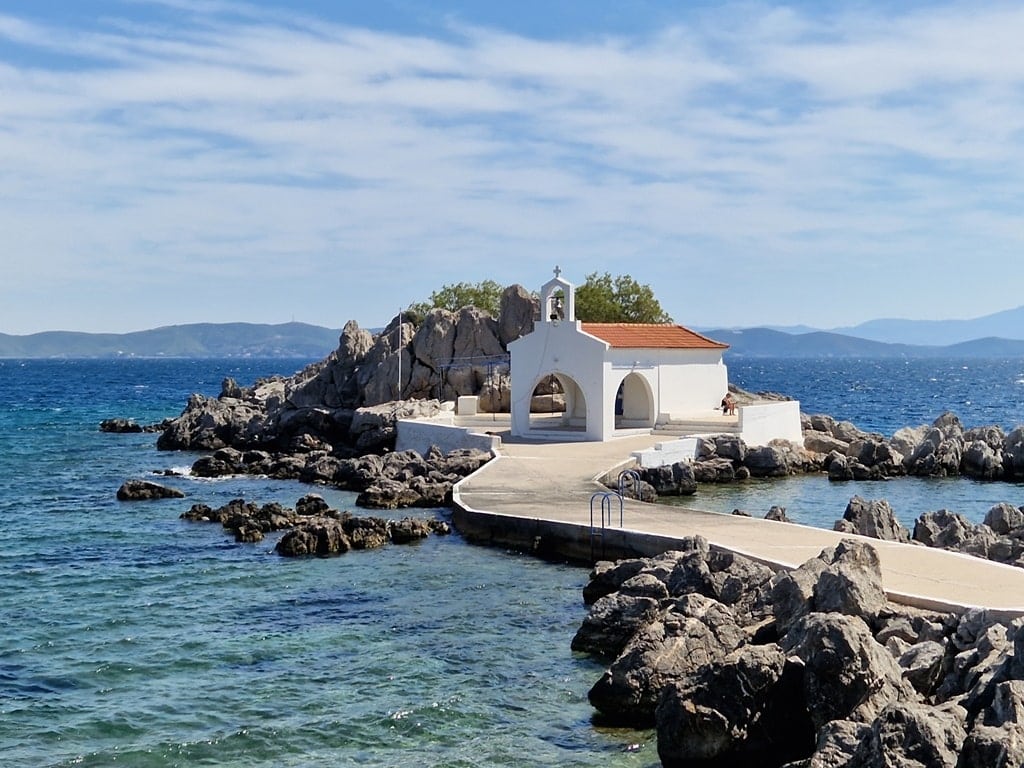
Aghios Isidoros is said to have arrived from Egypt and brought Christianity to the island during the era of Roman emperor Decius.
Aghios Minas Monastery: The monastery of Aghios Minas is roughly 9 km from the center of Chios’ Chora. It was founded in the 15th century and was very prominent and central to local activity, with many different buildings making up a complex.
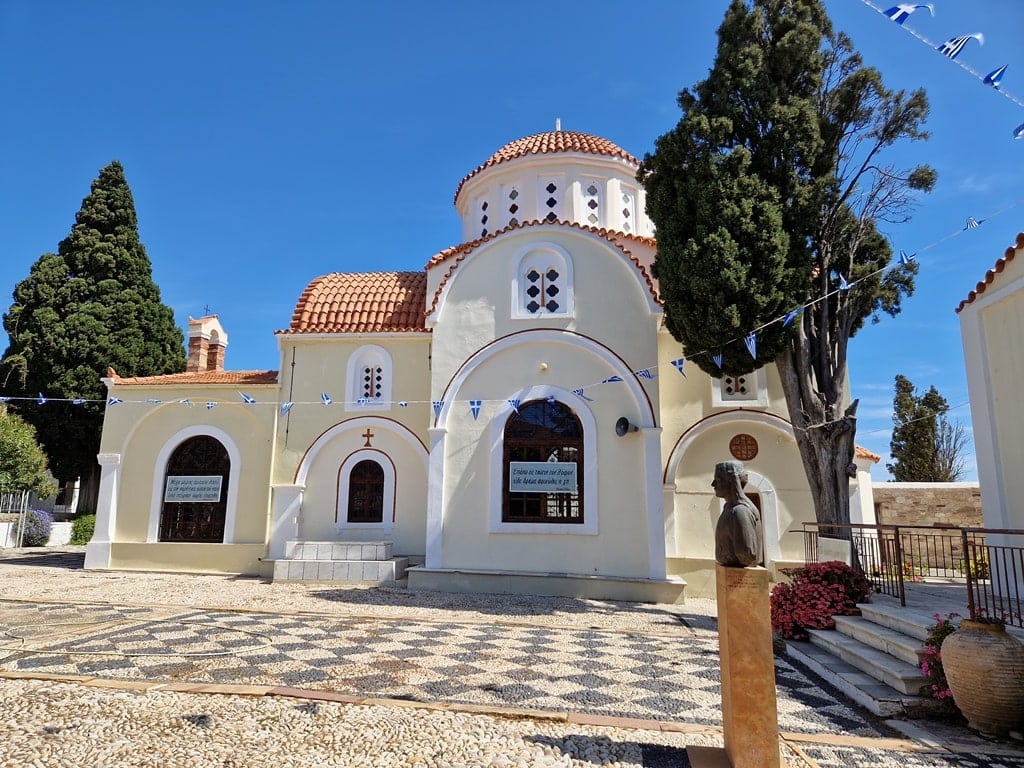
During the Massacre of Chios in 1822, the Ottomans sacked the monastery and burned everyone who had sought refuge there. The fire was so intense that the blood and shadows of the killed people were imprinted on the tiles of the monastery, and you can still see them today.
Explore the mastic villages (Mastichohoria)
The famed Mastichohoria, the mastic villages of Chios, is a stunning cluster of fortified villages built in the 14th century during the Genoese rule in the southwest of Chios. The Genoese valued the mastic production so much that they fortified the villages to protect it. Even the Ottomans spared the mastic villages during the Massacre of Chios.
Vessa
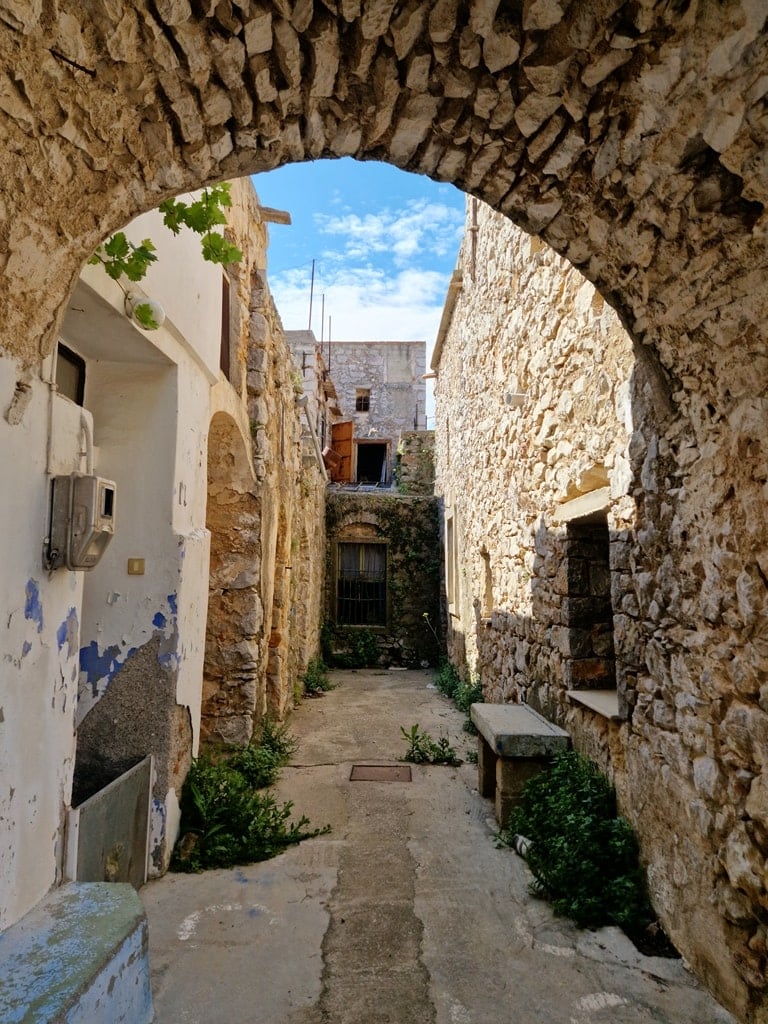
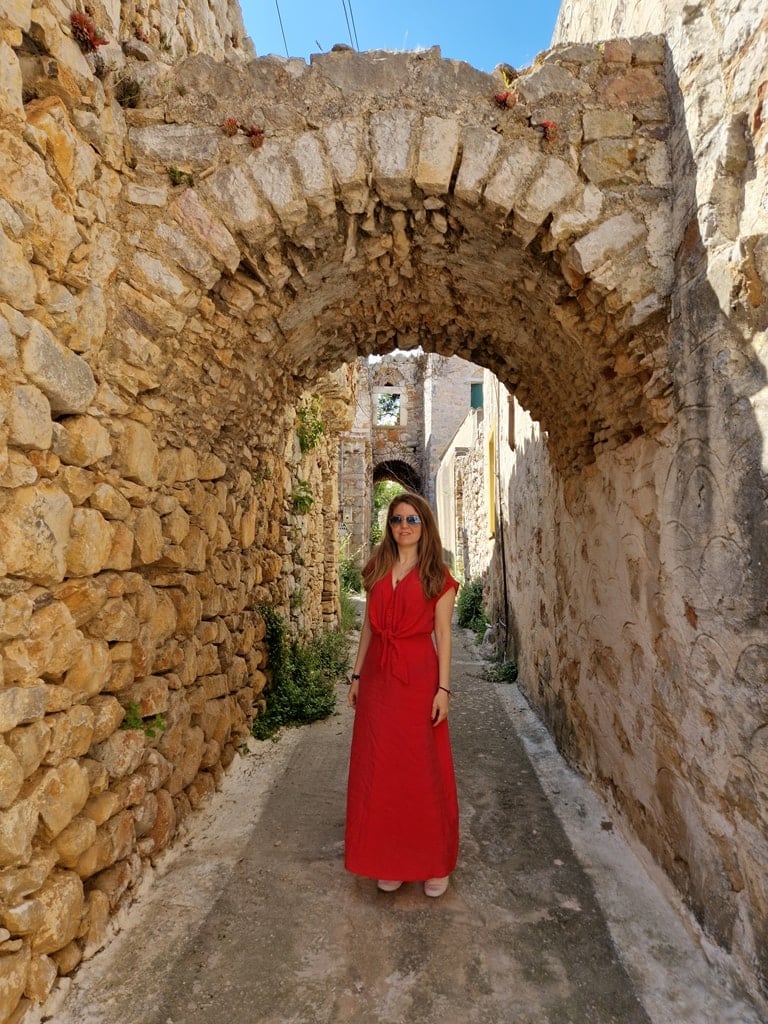
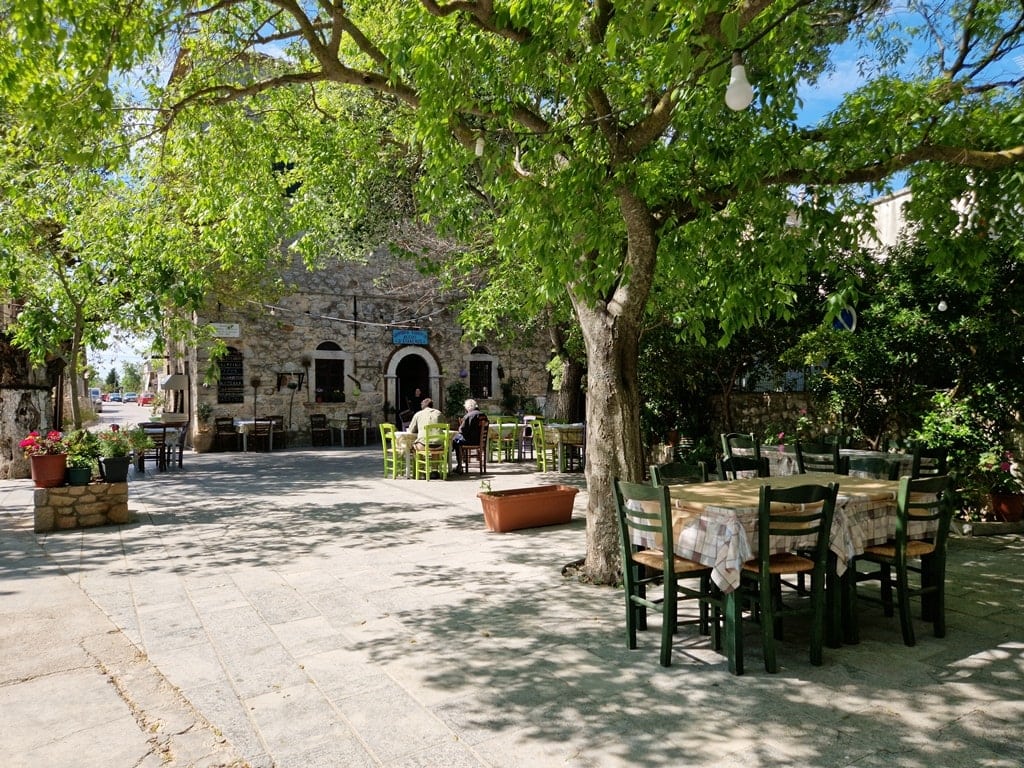
Vessa village was built in the 10th century and is a typical Byzantine castle village. Vessa is known for its stunning architecture and the picturesque narrow streets, the local produce, the mastic trees, and the wild flora that can be enjoyed all around the village, from rare wild tulips and indigenous orchids to fragrant herbs.
Mesta
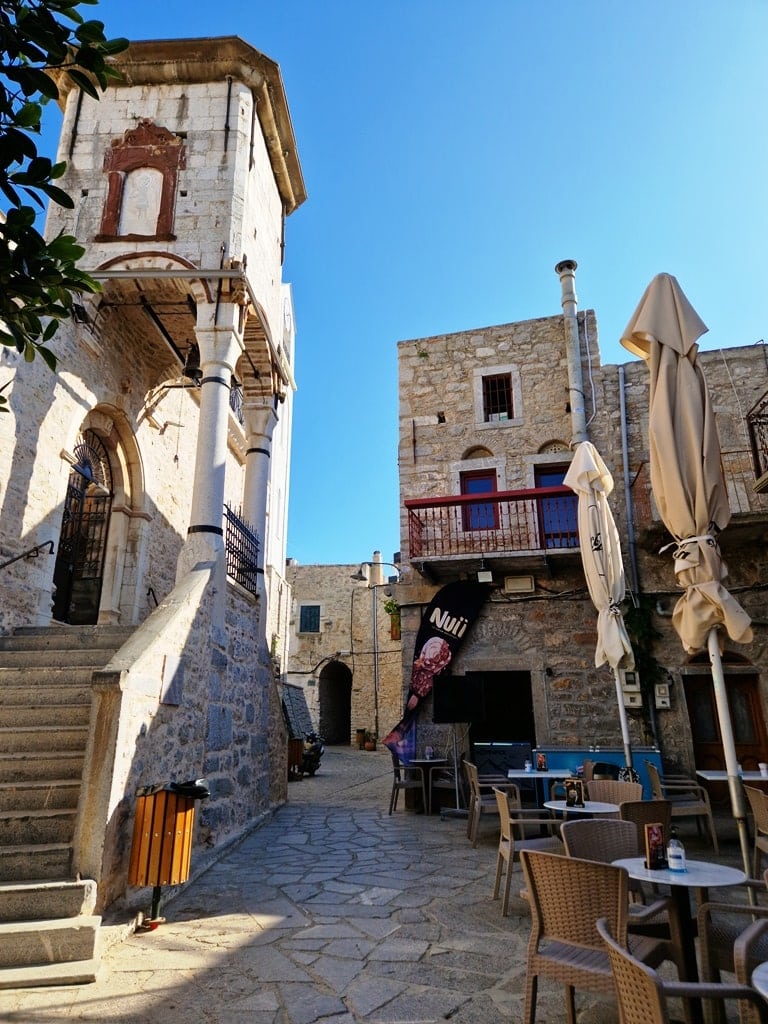
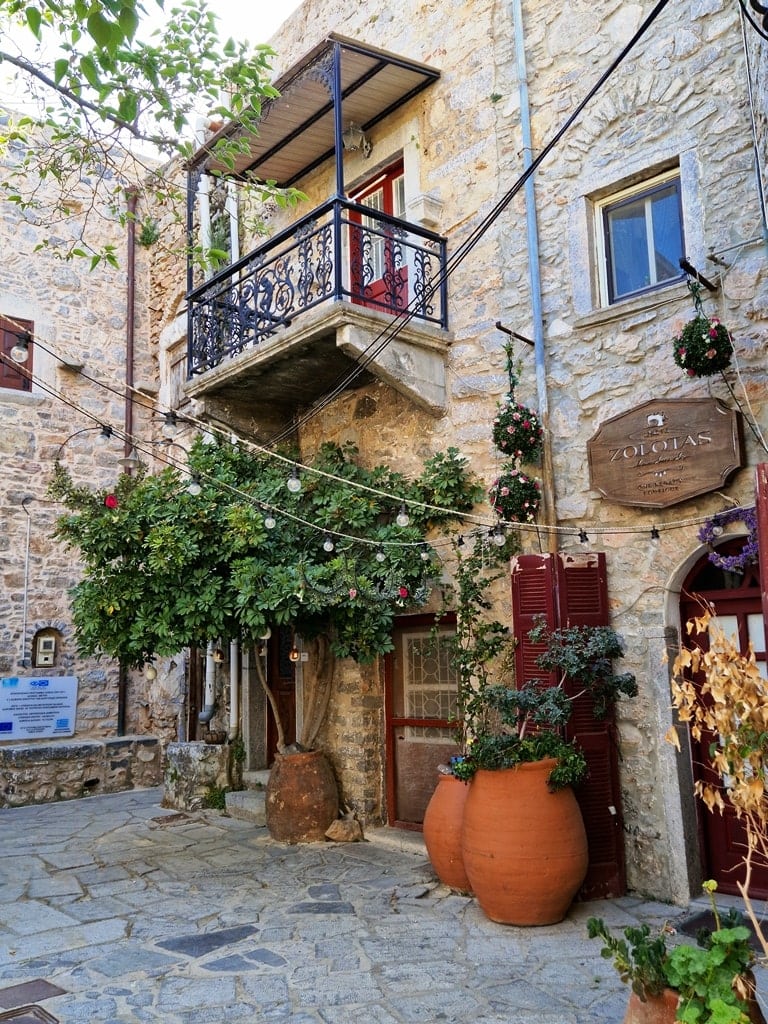
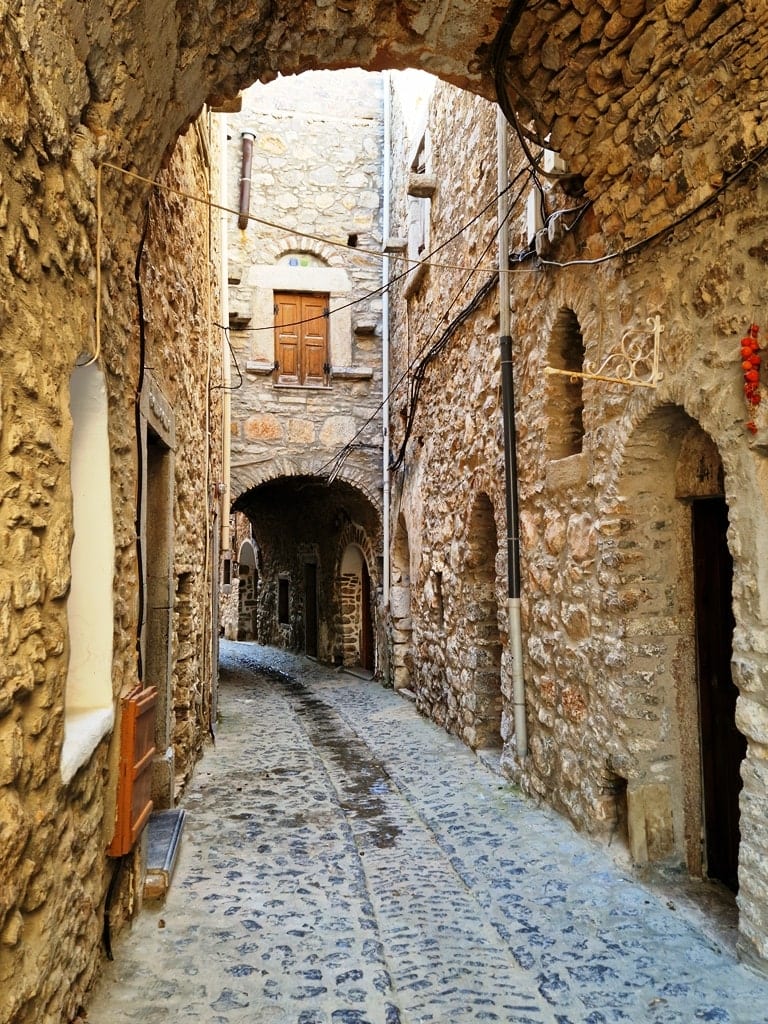
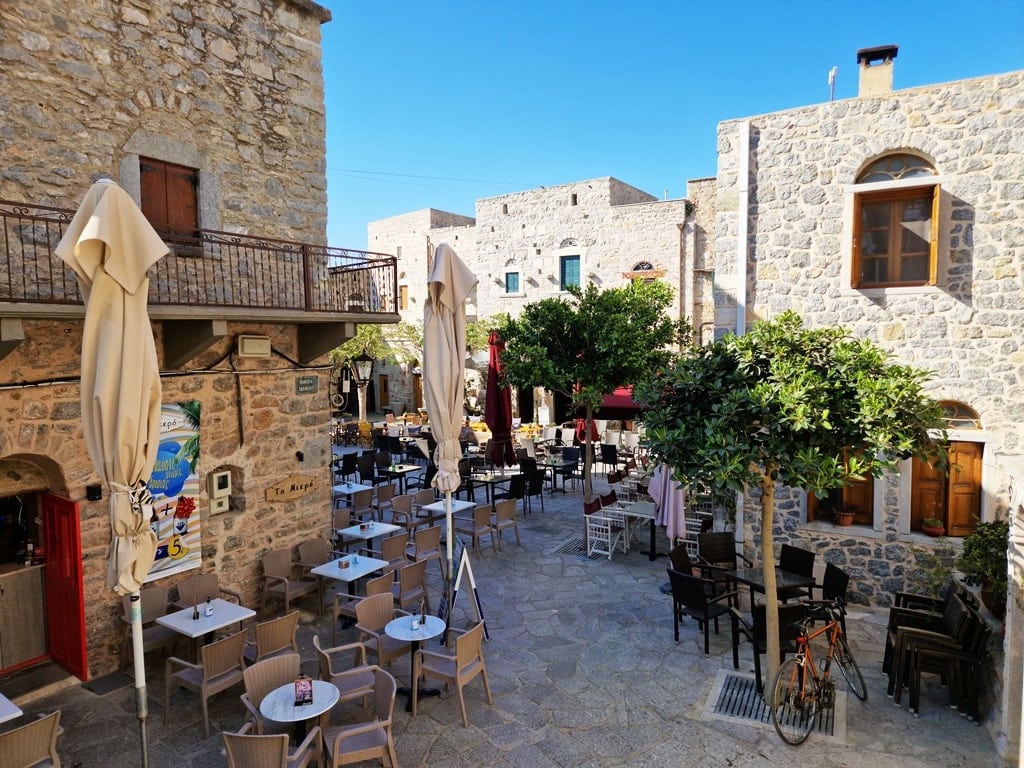
Yet another stunningly beautiful medieval castle village, Mesta offers a trip back in time to the height of the mastic villages’ affluence. Don’t miss out on visiting the church of Aghios Taxiarhis (the Archangel) with the gorgeous carved wooden iconostasis, which is considered a prime example of the best Chian woodcarving.
Olymbi
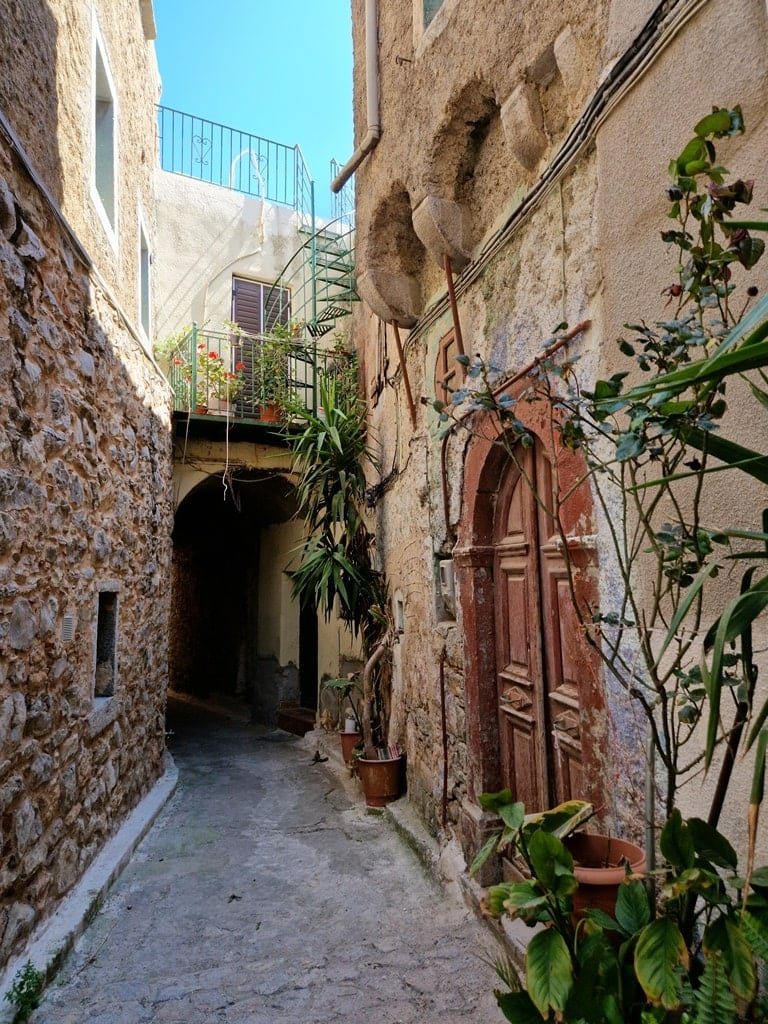
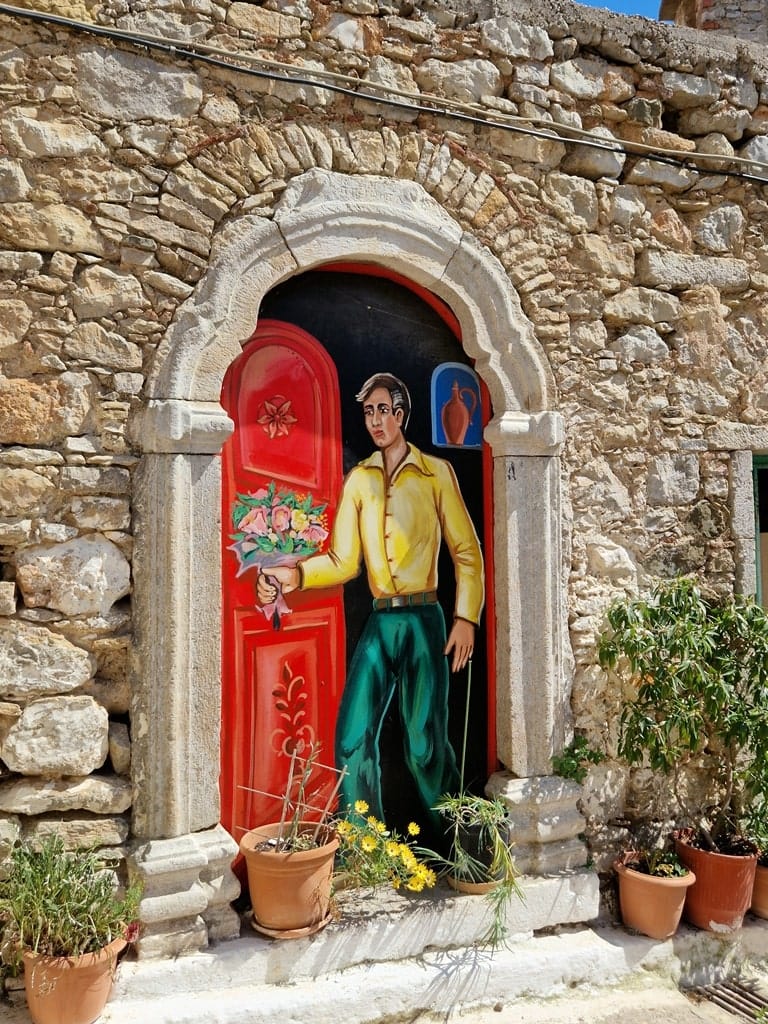
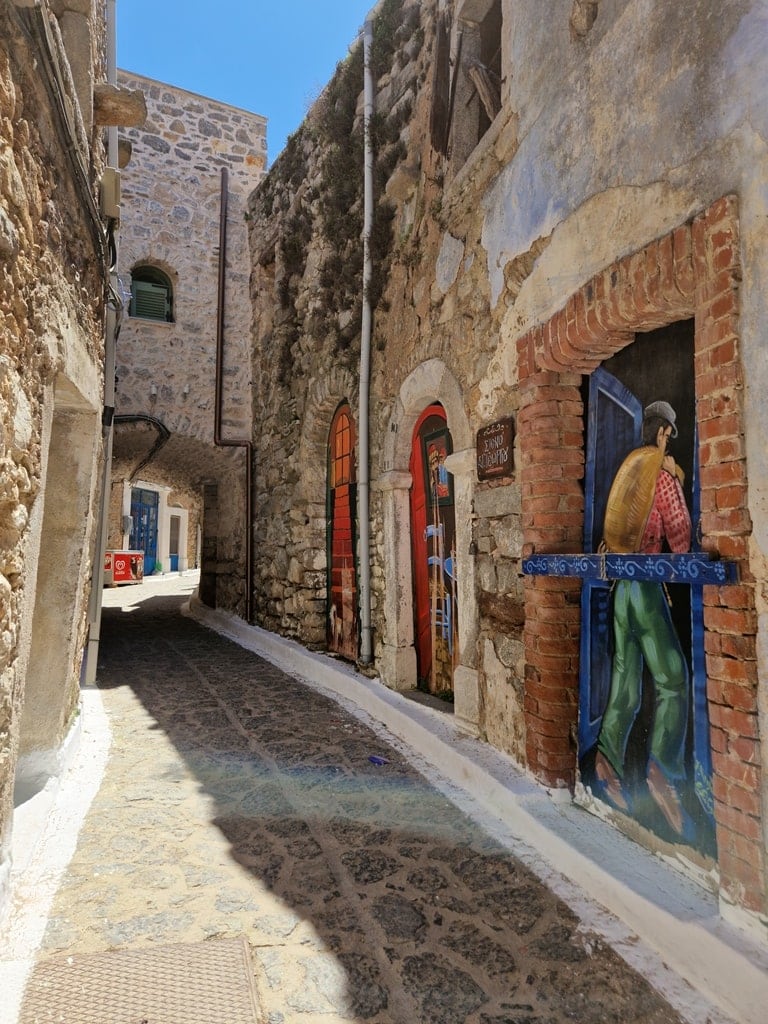
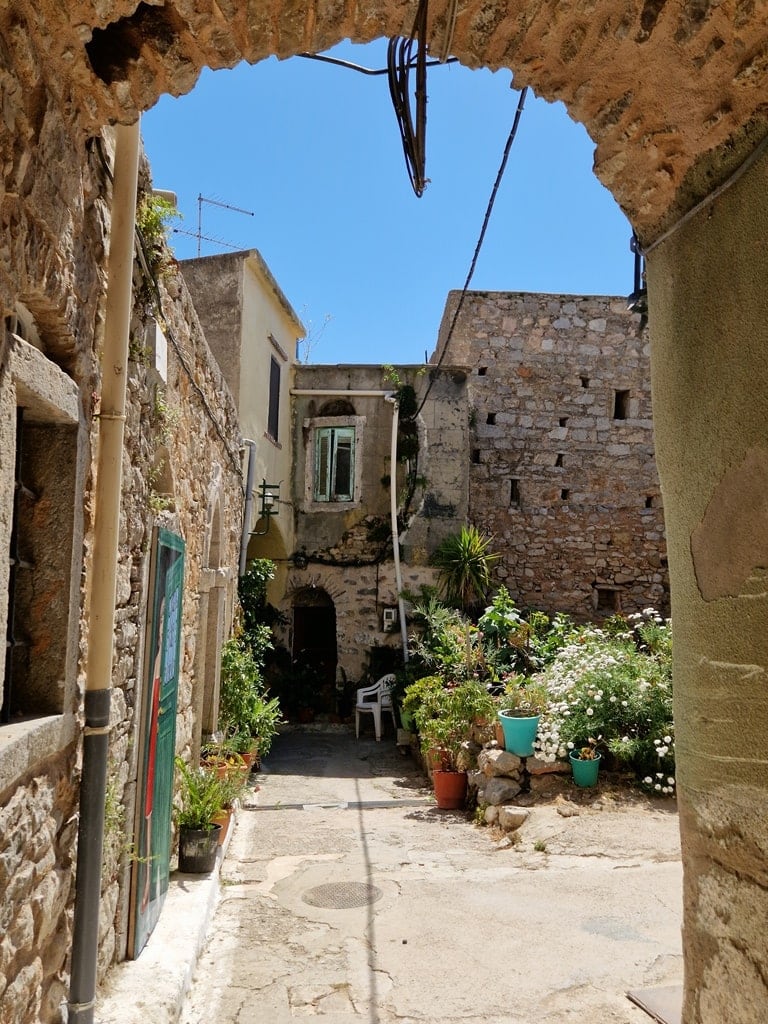
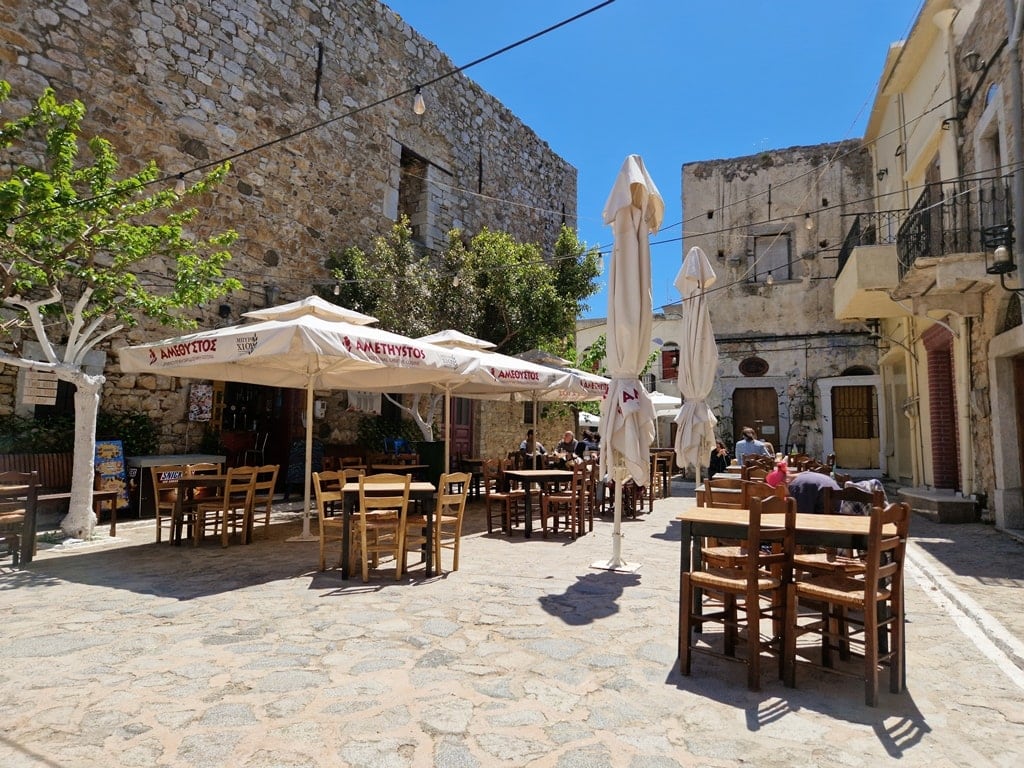
Olymbi was also built as a castle village, fortified with a central gate and defensive tower. You can enjoy unique promenades through the arched pathways that connect all the houses in the village. Don’t forget to visit the Olymbi Trapeza, a two-floor house in excellent condition from the early medieval period.
Armolia
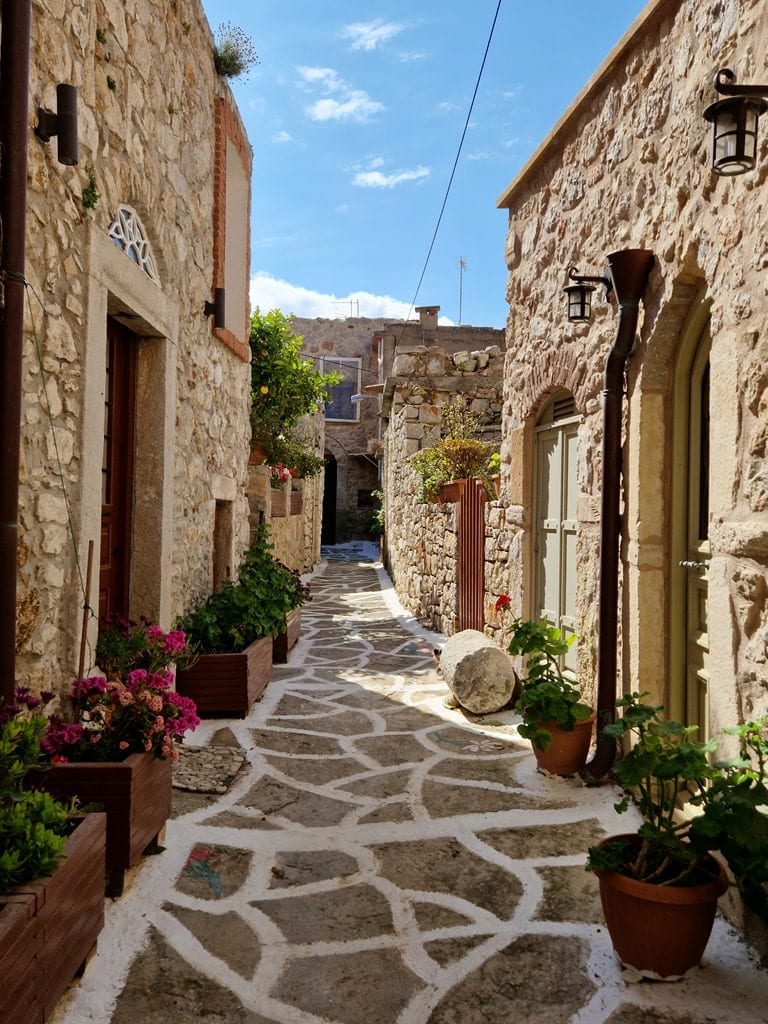
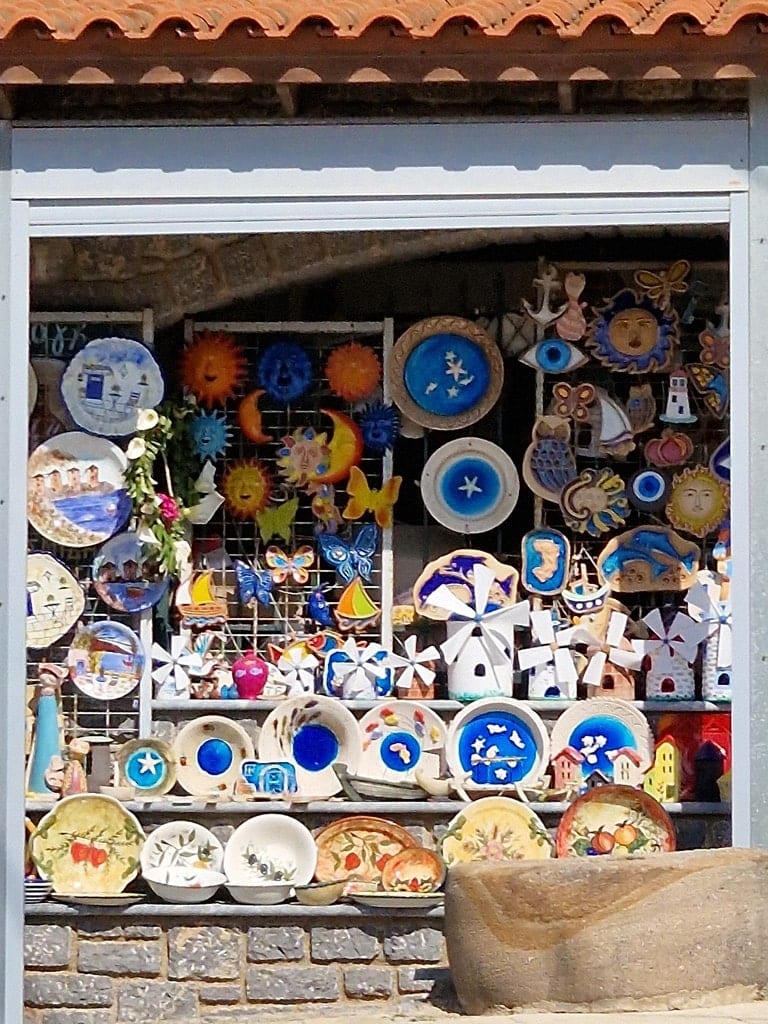
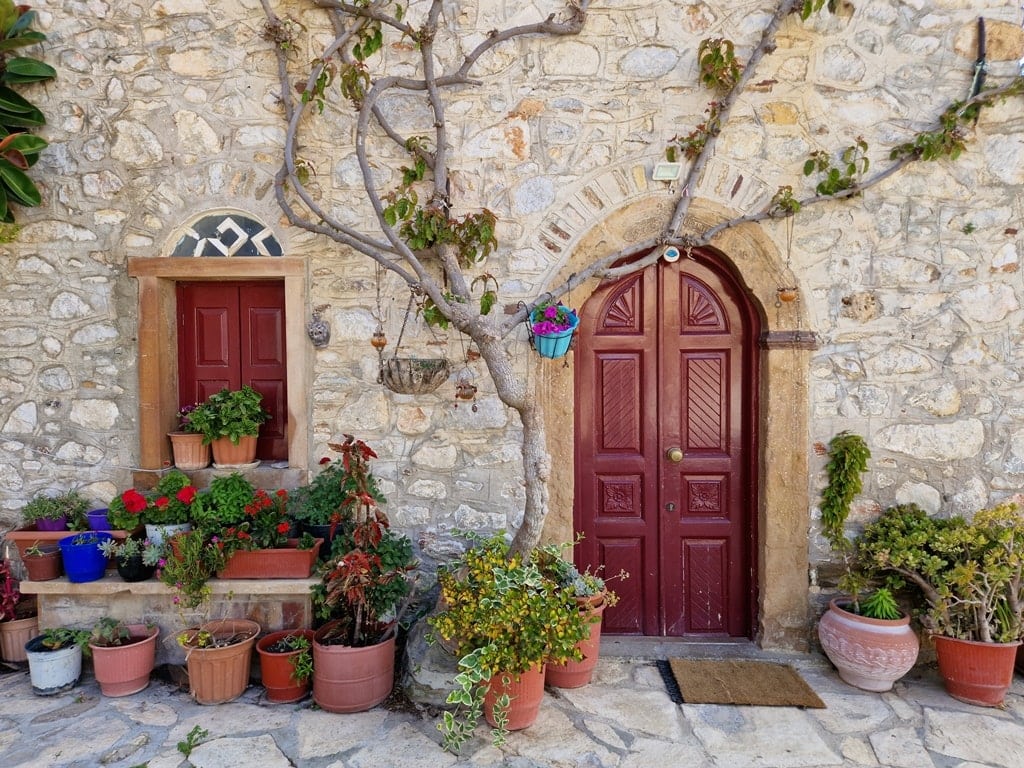
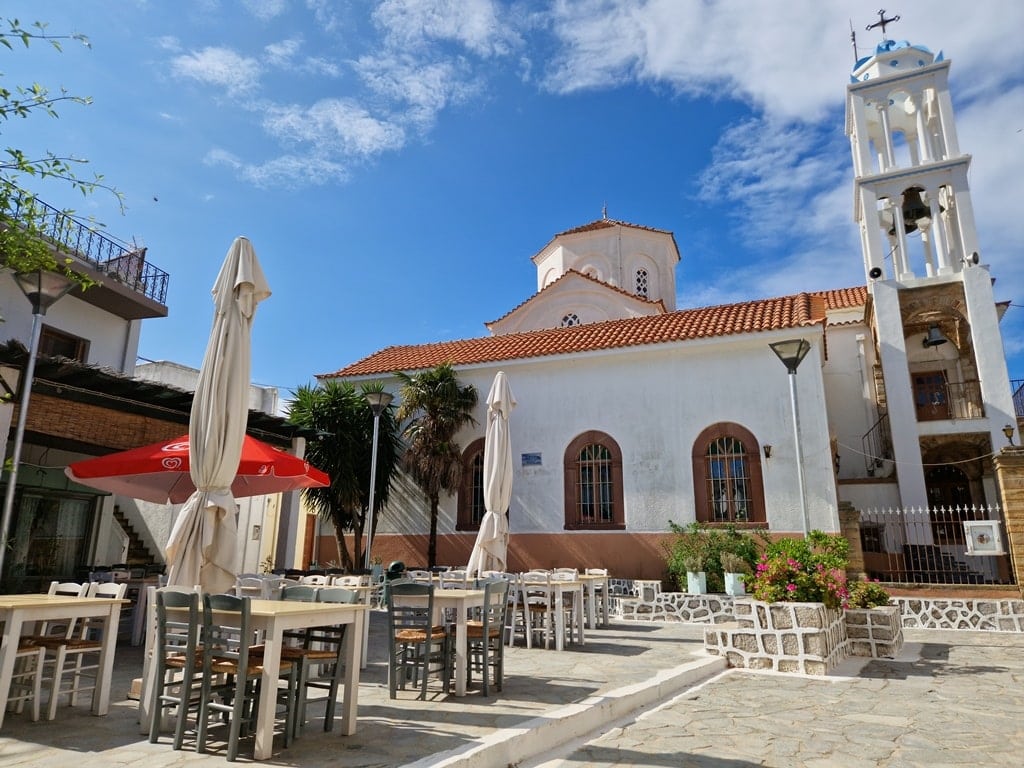
Armolia is the fortified castle village considered the central command of all mastic production. It is most famous for its excellent pottery and mastic production. The church of Aghios Dimitrios in Armolia has the most beautiful iconostasis, made in 1744.
Pirgi
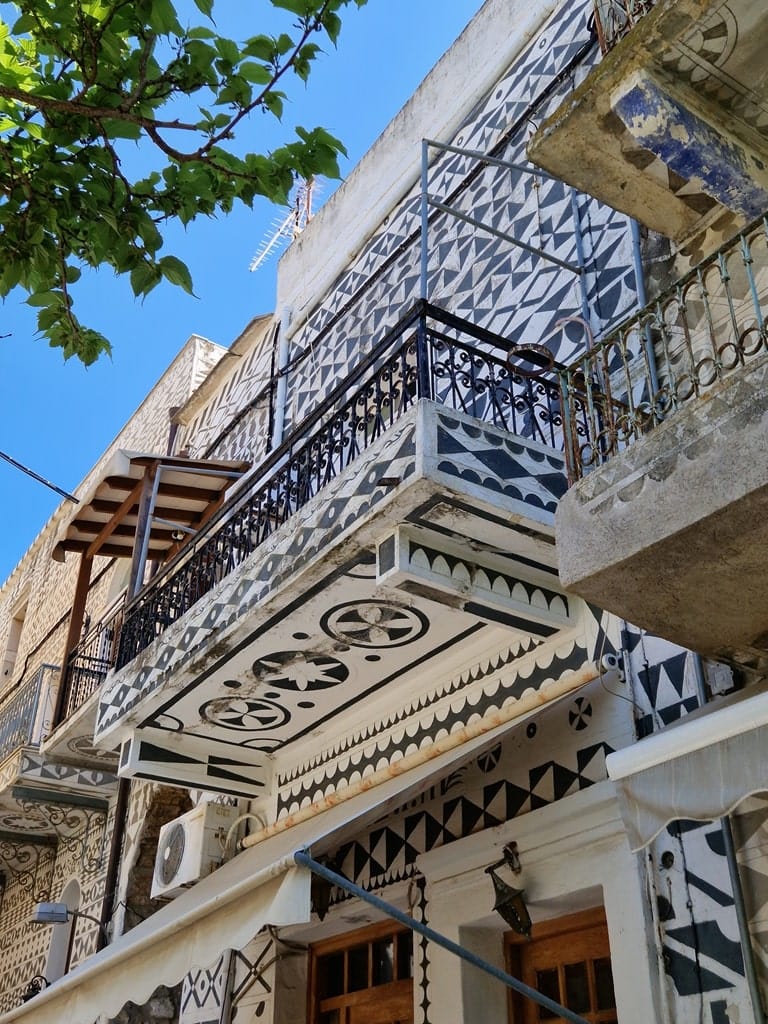
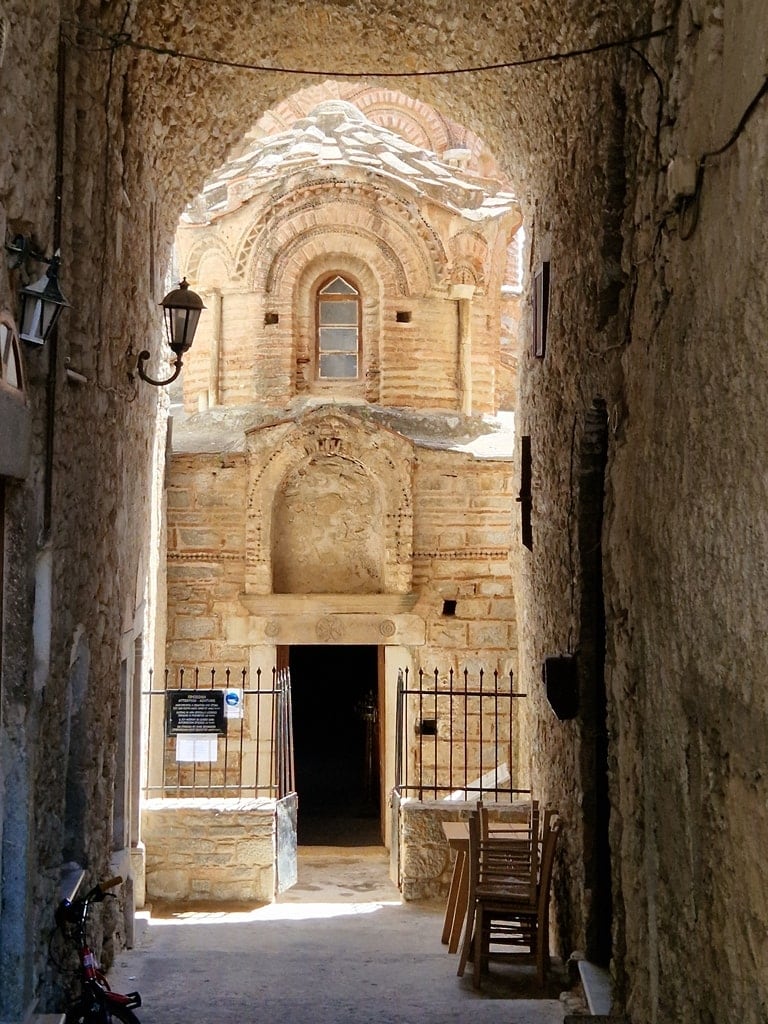
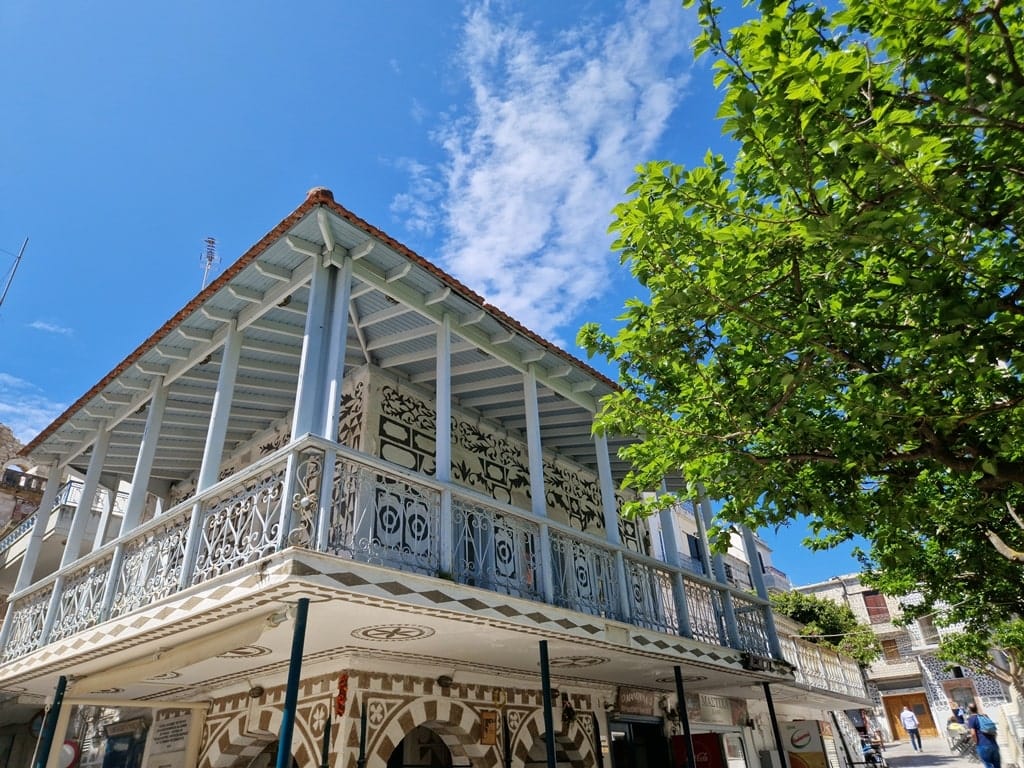
Pirgi is also fortified, just like the other mastic villages. Still, it is also known as the “painted village”: the fronts of most houses are painted in various geometric patterns that usually are pretty complex. Enjoy the feeling of being in a highly artistic yet practically fortified village. Visit its church Aghioi Apostoloi with stunning decorations and unique frescoes.
Visit historic villages
Avgonyma
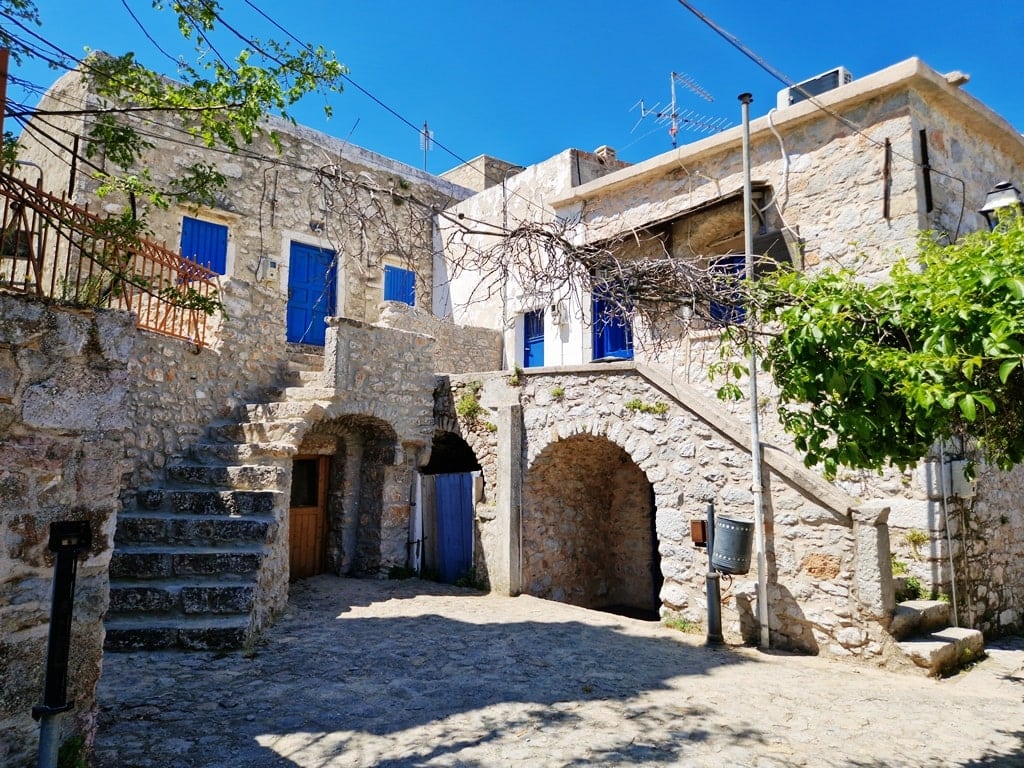
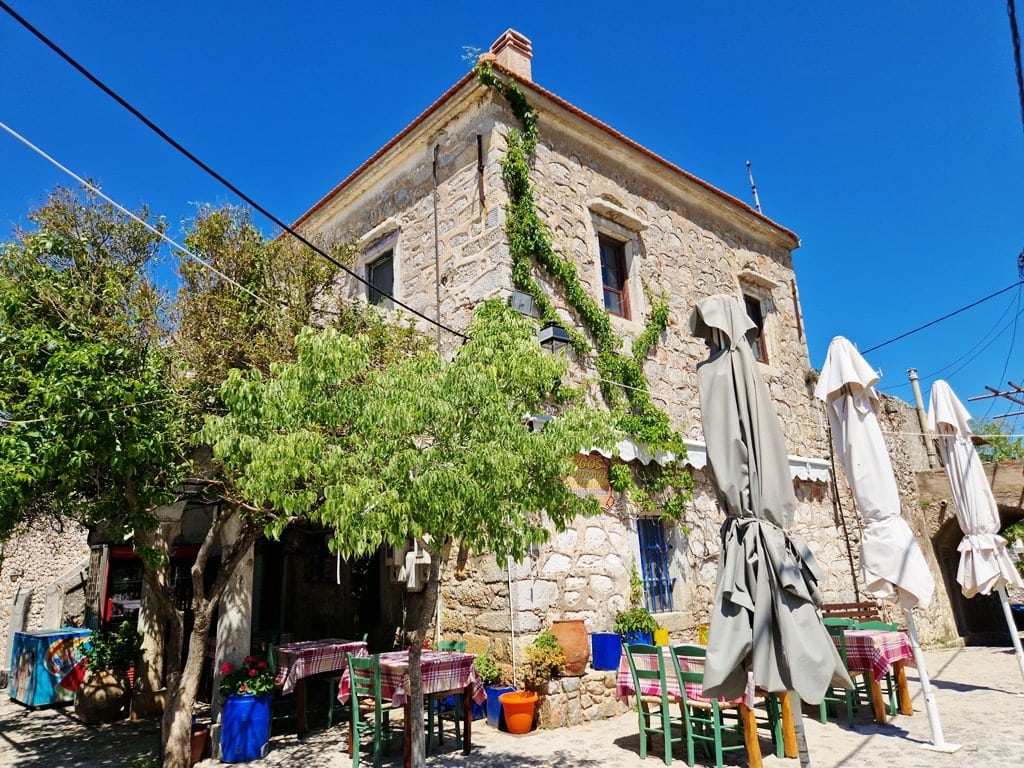
Avgonyma is a village 16km from the center of Chios’ Chora. You will transverse the island’s most important pine tree forest to reach it. The village is arranged in a defensive manner, like a castle village. You will walk through gorgeous, picturesque pathways and beautiful sweeping views.
Volissos
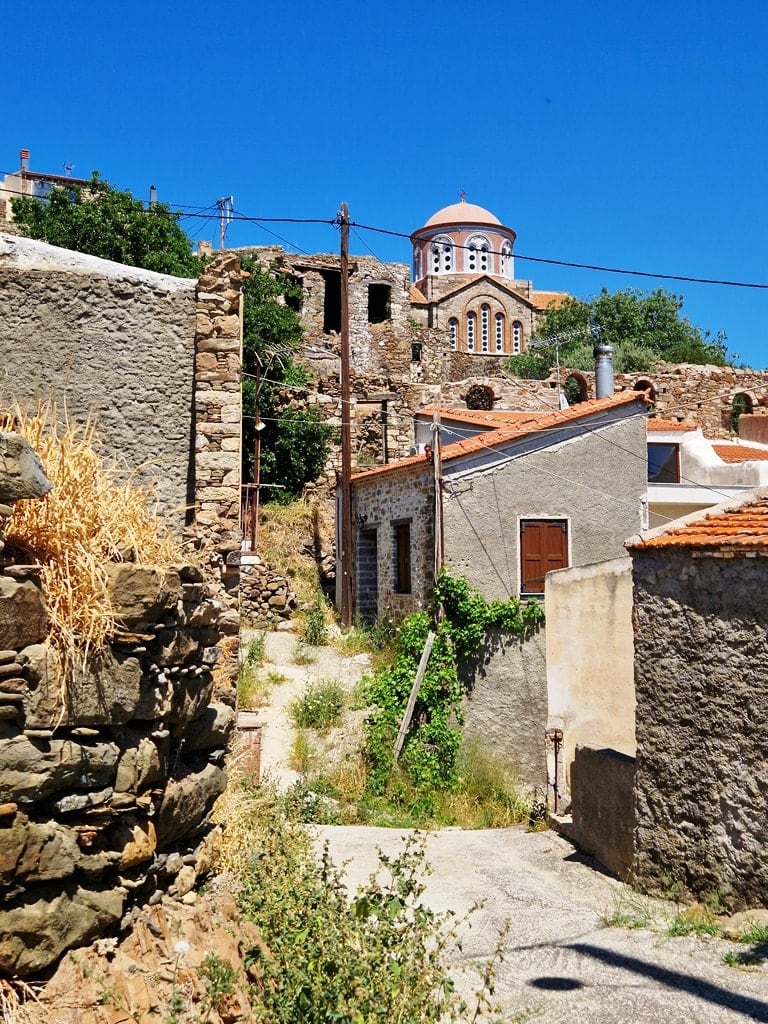
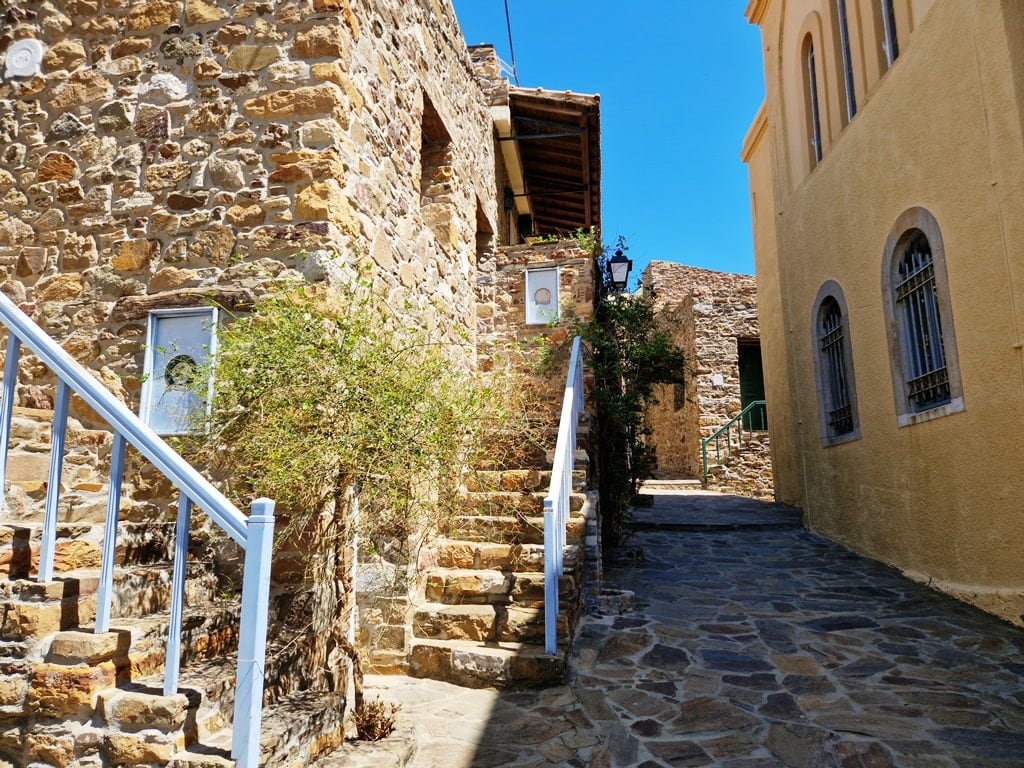
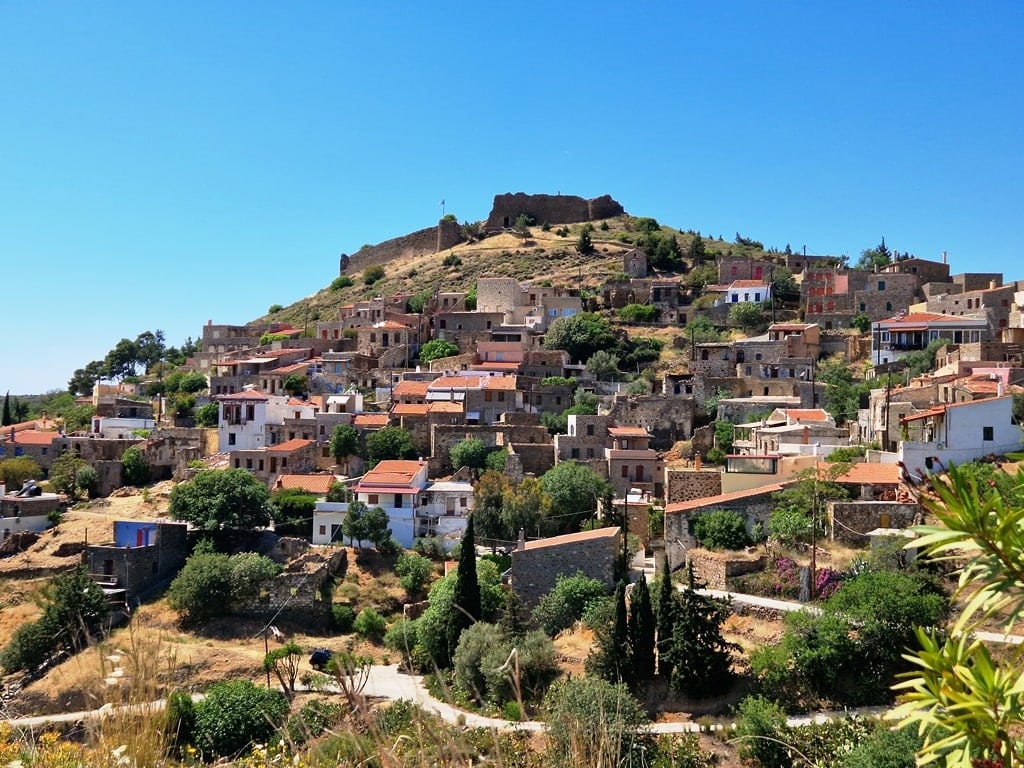
Volissos is the biggest village in northwest Chios. It is also of the oldest settlements on the island, mentioned in the works of Thucydides. Volissos is simply gorgeous with unique stone mansions and old traditional homes. There is also special lighting showing the castle ruins looming over the village at night.
Palia Potamia
This small village is abandoned but still stands. It was very well hidden in a ravine to avoid being noticed by pirates. The village has interesting stone buildings, including a schoolhouse that the villagers built and a beautiful church.
Anavatos
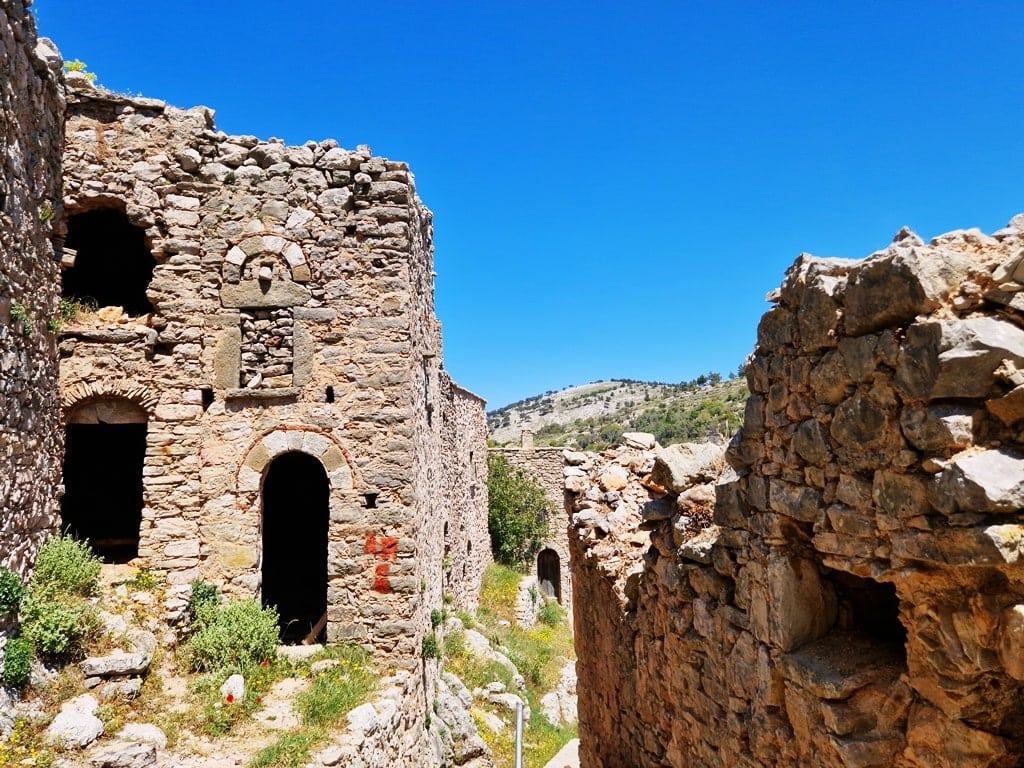
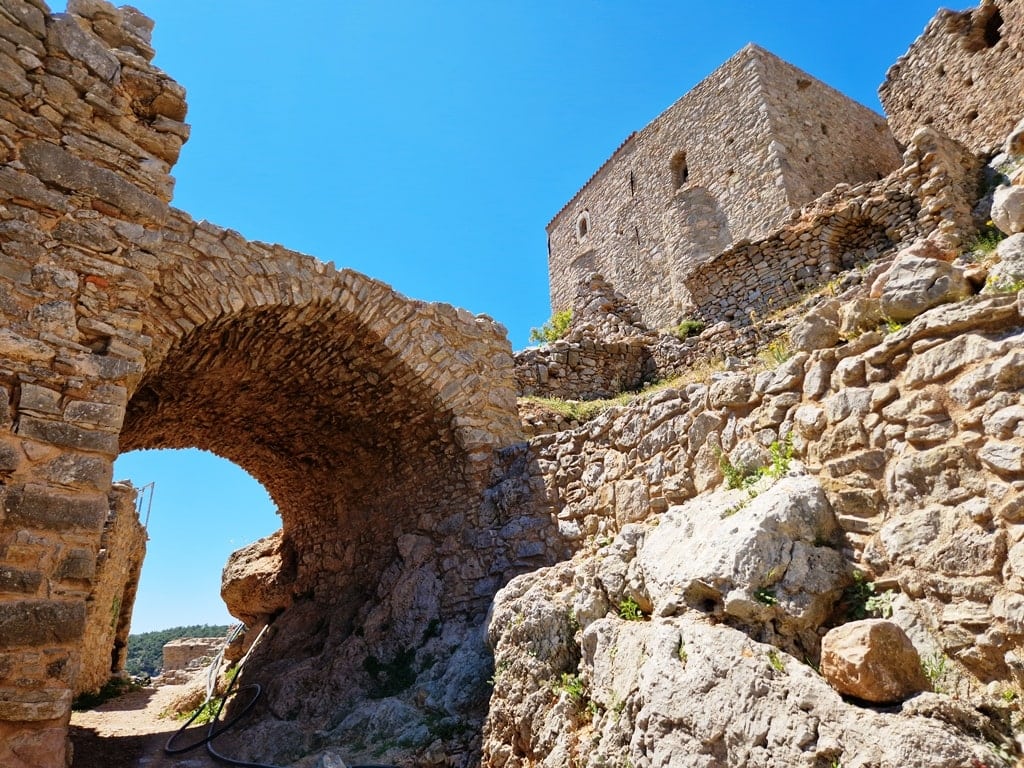
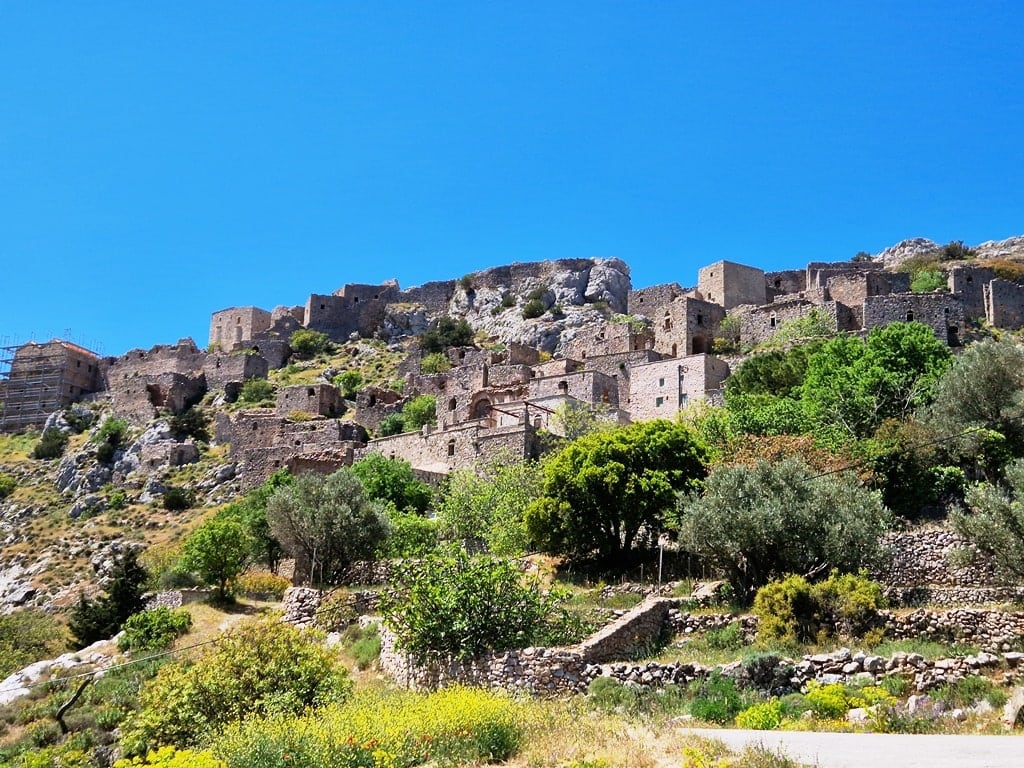
16 km from Chios’ Chora, you will find the deserted, medieval tower village of Anavatos. The houses of Anavatos are iconic and imposing, built as fortifications at the top of a granite cliff. Walk its narrow cobbled pathways and visit the church of the Taxiarchis (meaning ‘Archangel’) that is preserved. The village was central during the Greek War of Independence and in the events of the Massacre of Chios in 1822.
See the caves
Cave of Olympi: The stunning cave of Olympi is in the south part of Chios, near the village of Olympi. It is a relatively small cave but boasts impressive compositions of stalactites and stalagmites and peculiar formations created by the wind currents in the cave.
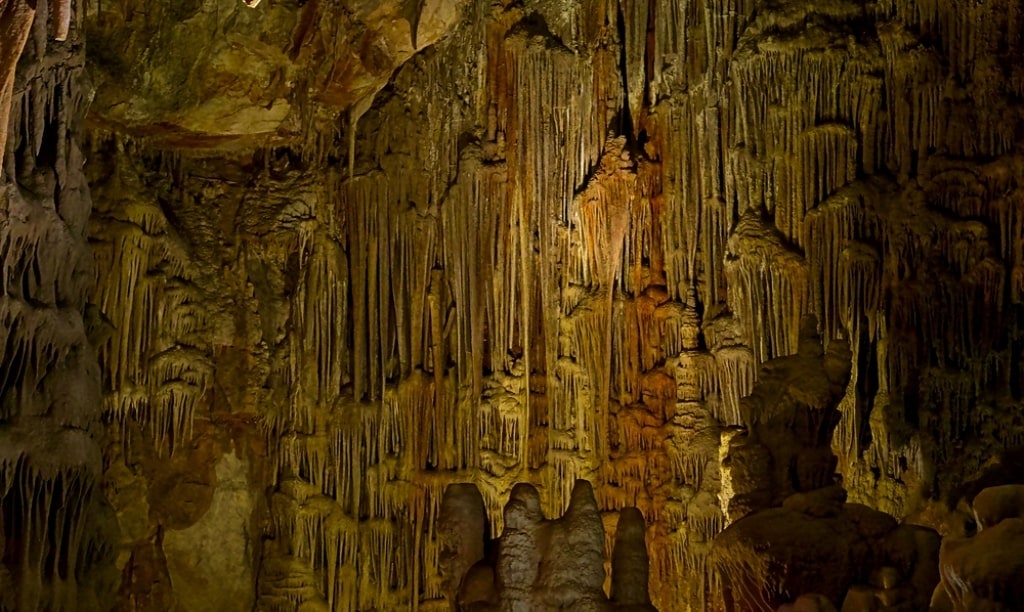
Cave of Agio Gala: You will find the Cave of Aghios Galas about 72 km from the center of Chios’ Chora. Just like the cave of Olympi, this one features gorgeous sets of stalactites and stalagmites, but it also features human habitation traces.
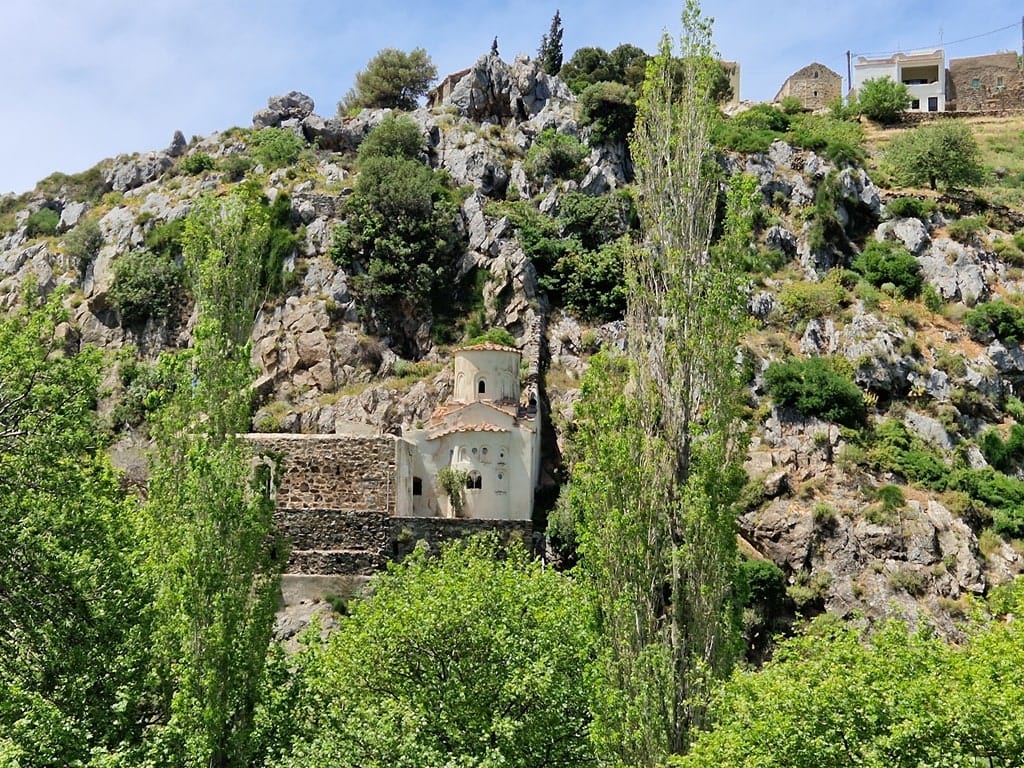
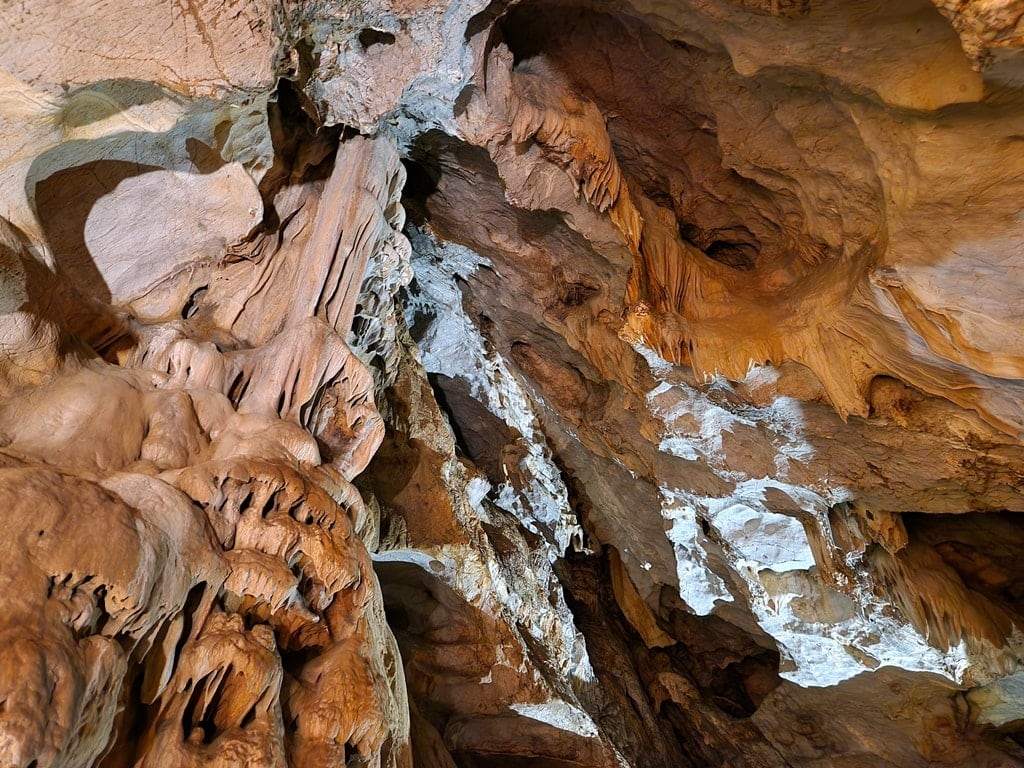
The cave has been inhabited since the Neolithic era and was periodically used as a sanctuary by various groups, including early Christians. There is also a tiny chapel dedicated to Aghia Anna in the cave.
Relax with a soak in the thermal baths of Agiasmata
Agiasmata is in the north of Chios, about 55 km from the center of Chios’ Chora. It is well known for its natural thermal baths, which are rich in minerals and great for rheumatism and similar conditions. The facilities are quite near the beach, so they are an excellent choice for a special spa day!
Visit the villages of Kampos and the Museum of Citrus Fruits
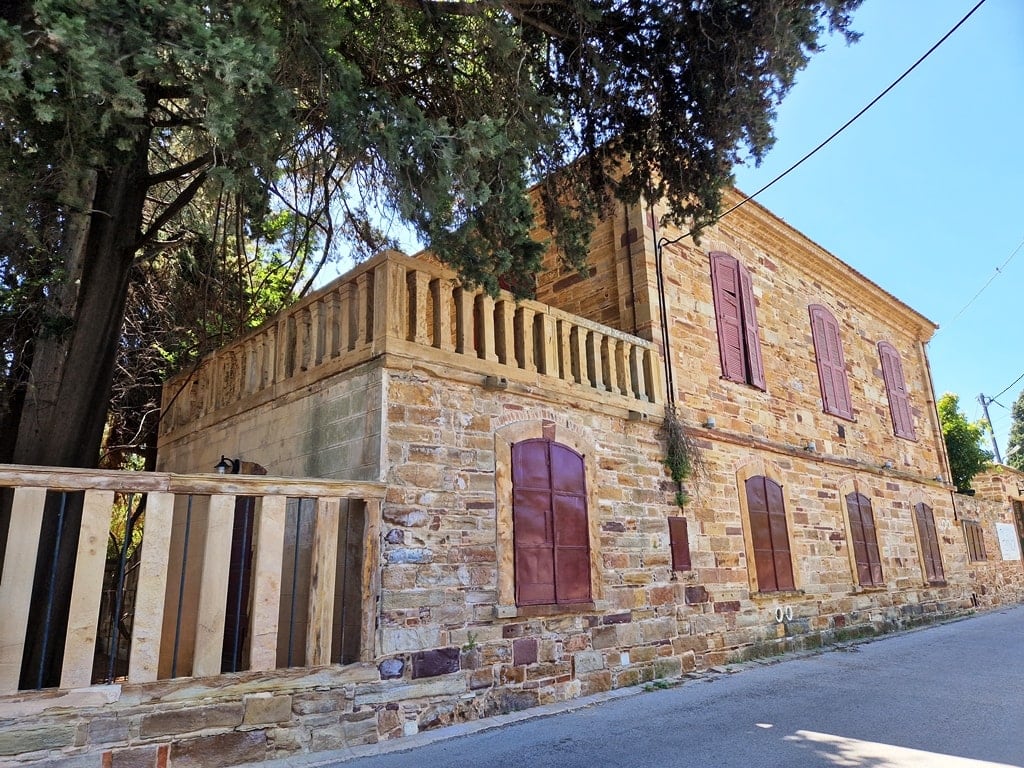
Kampos is a unique, gorgeous village famous for its opulent mansions. Many were built during the Genoese era as fortifications and were later converted into rich mansions in the 17th and 18th centuries.
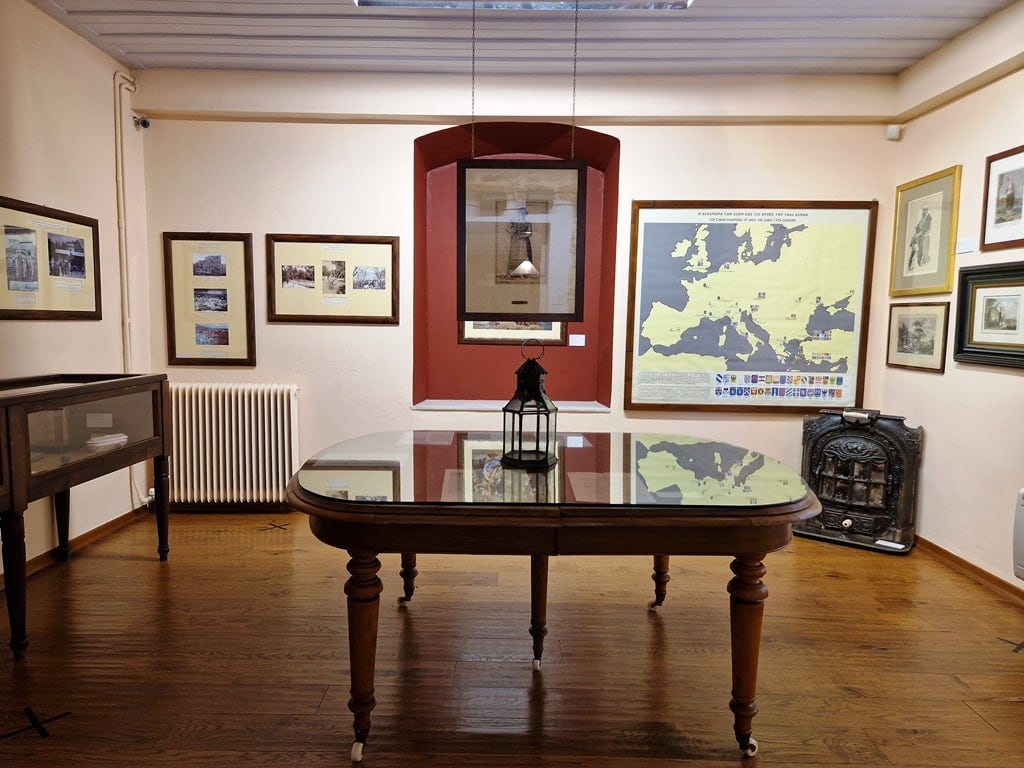
Kampos’ name means “valley” because it is located in a large valley overgrown with an orchard upon an orchard of citrus trees. Because the village was established by farmers and aristocrats alike, the mansions are opulent but perfectly designed to support agricultural work.
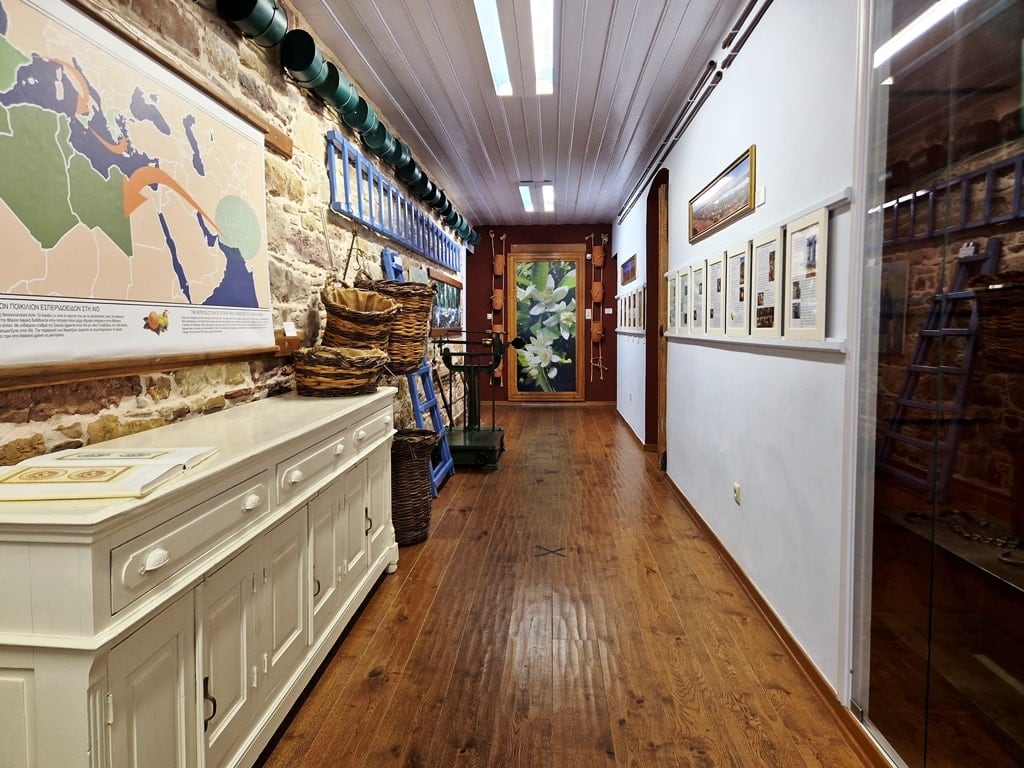
Kampos is renowned for its citrus fruit, which is why there is even a museum for them! Housed in a beautiful 1700s mansion, the museum introduces the guests to the entire cultivation process of citrus trees and citrus fruit production.
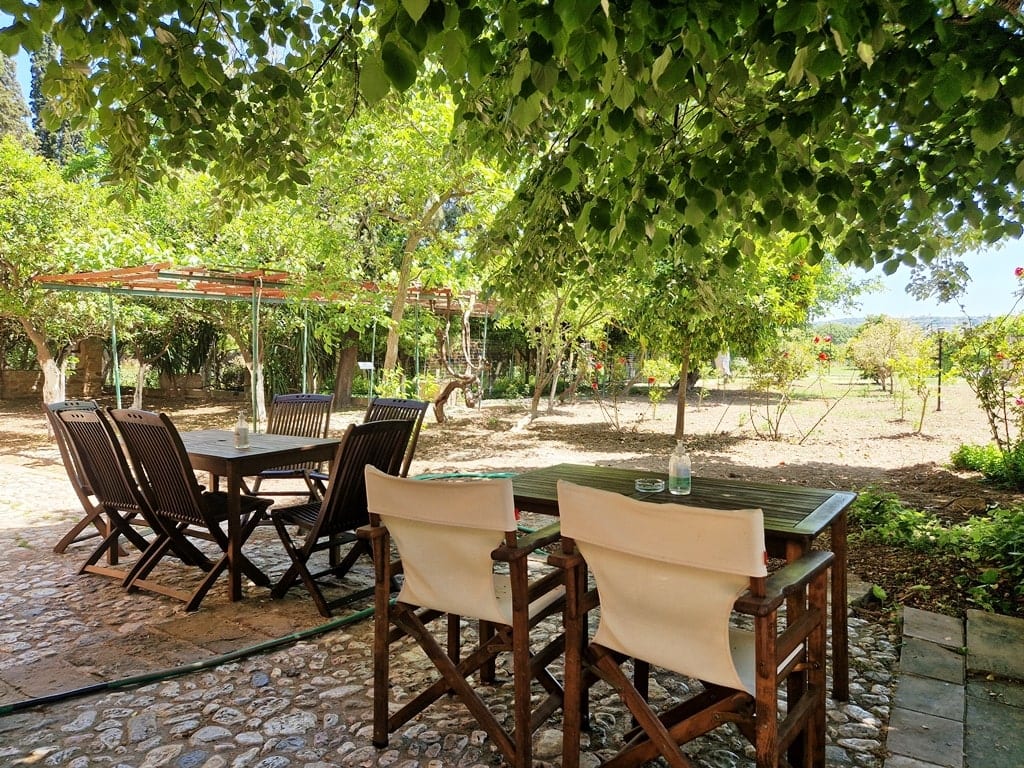
Captivating displays and videos demonstrate a massive part of the cultural history of Chios. The characteristic fragrance of Kampos’ citrus fruit will be unforgettable to anyone who visits!
Hit the beaches
Chios is known for its gorgeous beaches, so it’s impossible to list them all. Here are some of the best ones to begin your exploration:
Mavra Volia: Easily the most famous beach of Chios, Mavra Volia is a black sand beach created by the explosion of a prehistoric volcano. Impressive rock formations make a stark contrast with the black sand and the clear blue waters. Truly an unforgettable setting for great swims!
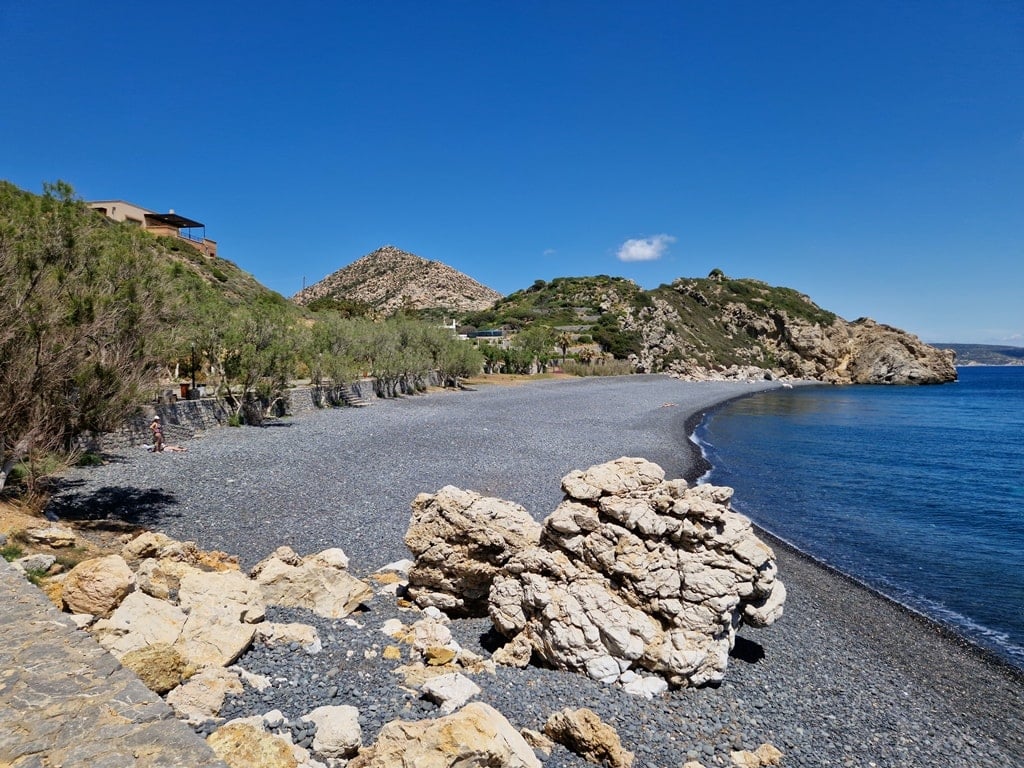
Vroulidia: This gorgeous little beach has golden sand and a stunning cliff face to one side. Beautiful azure waters, dashes of green from various trees, and a sense of wilderness make the beauty of this beach unique.
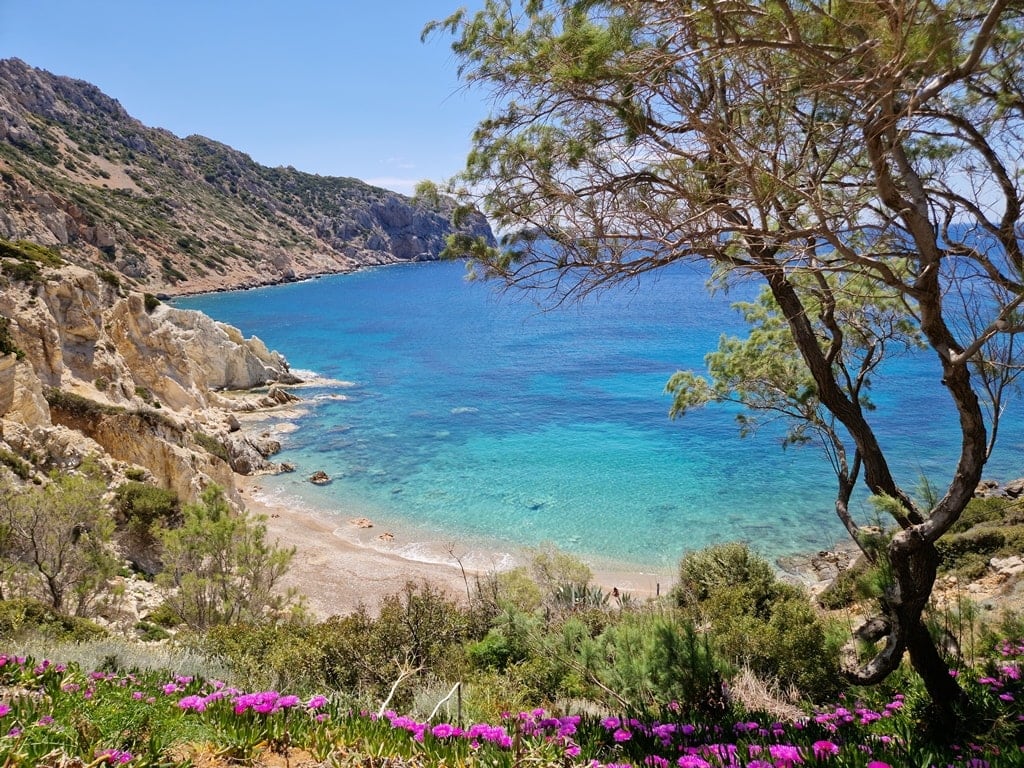
Agia Dynami: This beach is pristine, without any organization (so bring your shade and provisions!). The waters are a lush bright blue, and the sand is golden, with interesting formations that showcase its natural beauty.
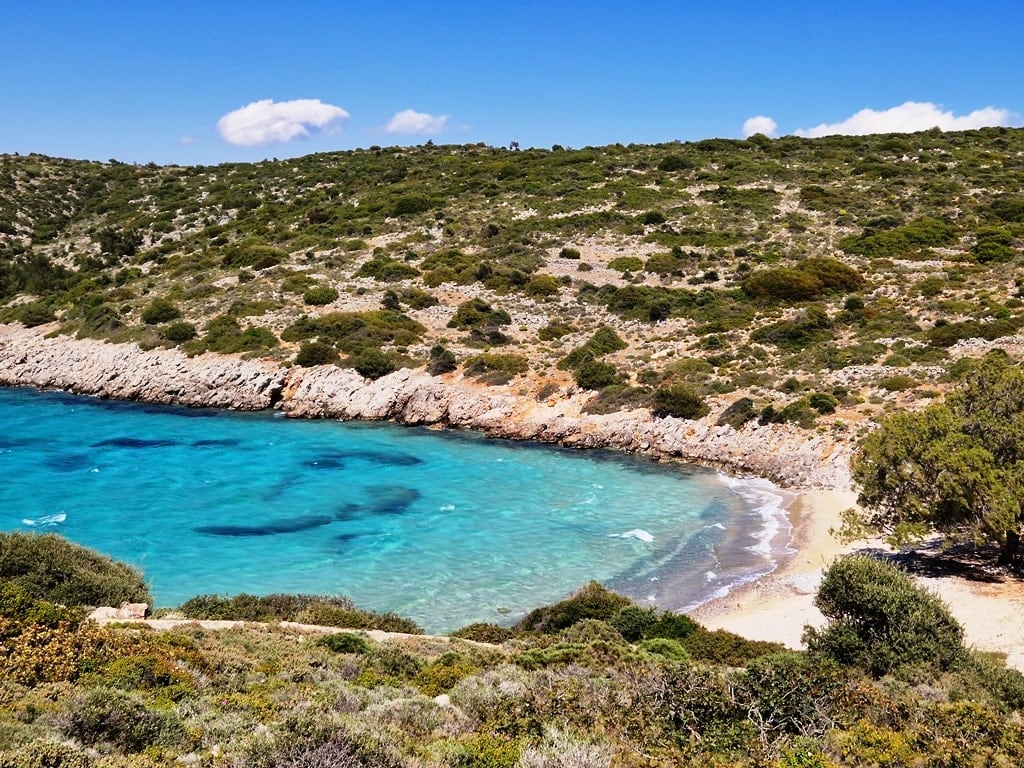
Elinta: Yet another gorgeous beach where the sapphire blue contrasts with the bright green of the trees at the shore, with golden, silky sand and a sense of seclusion and privacy. This one is also unorganized, so bring your provisions!
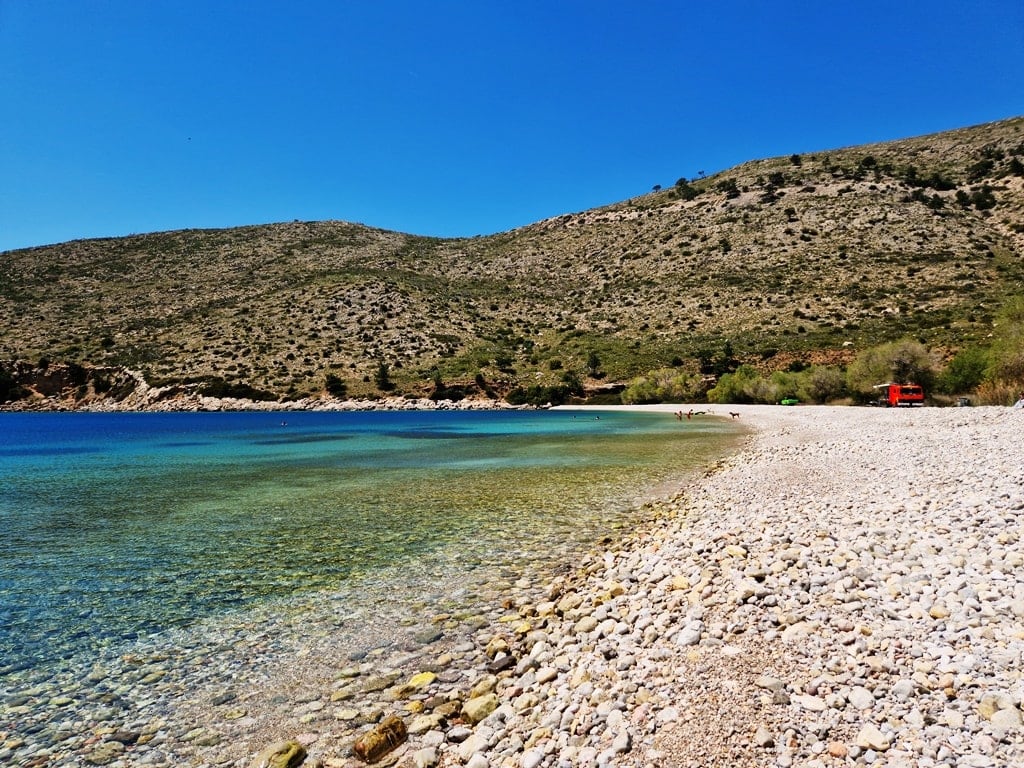
Take a day trip to Oinousses island
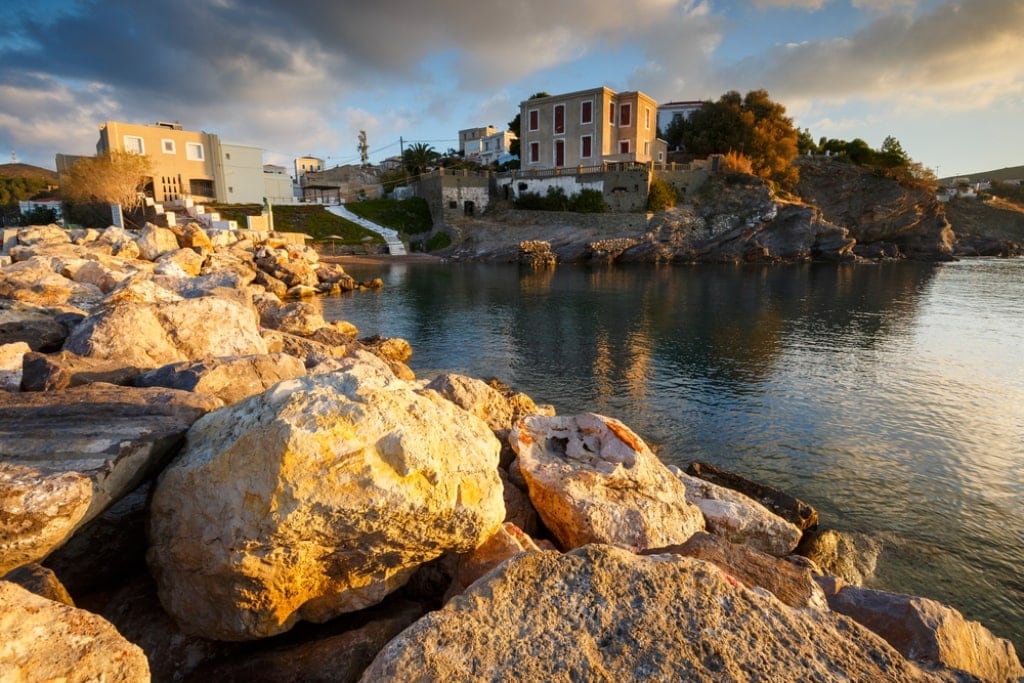
Oinousses is the biggest little island out of 8 tiny ones near Chios. The name means “of wine” because Oinousses was historically famous for its wine production. Take a day trip there and admire the gorgeous red-roof neoclassical houses, the beautiful square with the sculpture dedicated to the Unknown Sailor, and even visit the Maritime Museum there.
You might be interested in the Chios Inousses Lagada Semi-Private Sail Cruise.
Take a day trip to Çeşme and Izmir, Turkey
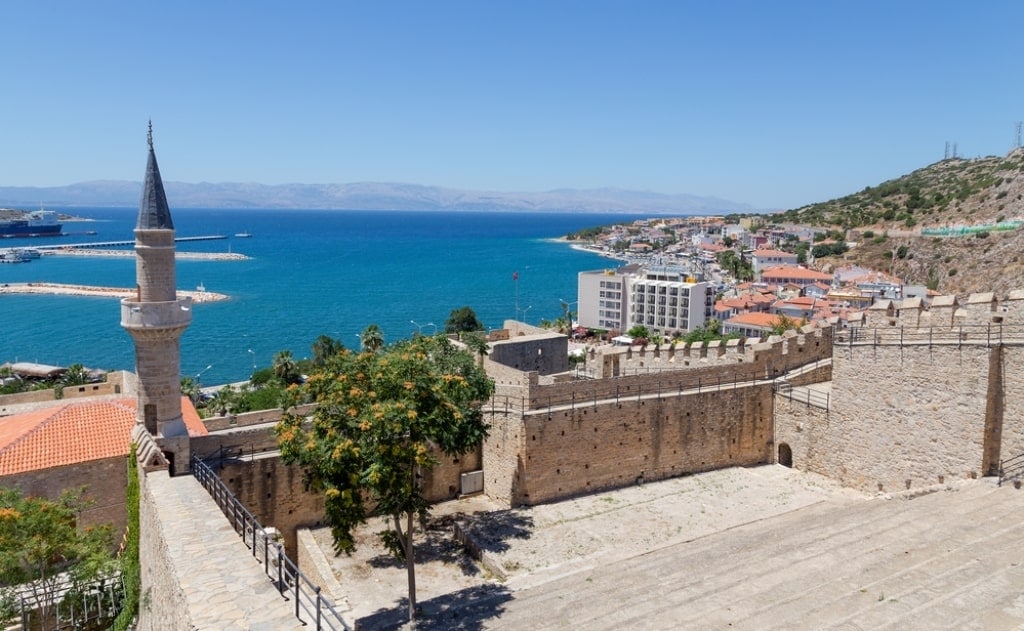
Because Chios is so close to Turkey, it’s an excellent opportunity to visit two of the most famous cities in Asia Minor, Çeşme and Izmir. The ferry trip is only 20 minutes long.
Visit the Castle and various historical buildings in the city, which has a rich history of Greek and Turkish people, taste the excellent wines, and glimpse the culture there. Izmir is quite close to Çeşme and is a significant city for Greece’s history and Turkey.
Before taking this trip, make sure you don’t need a Visa. If you do, it’s easy and relatively cheap to obtain one, so be prepared!
Visit Ariousios Winery
Since the time of Strabo, Chios’ wine was considered the best of all the Greek wine varieties. It is called Ariousian Wine, and it is said that Homer drank from it when reciting his poems. You will find the winery roughly 59 km from the center of Chios’ Chora, near the village of Egrigoros.
Visit the winery for some unforgettable wine tasting in a beautiful estate, take a tour, see how the wine is made, and discuss the joy of sampling good wine with the people there.
Check out Chios’ beer
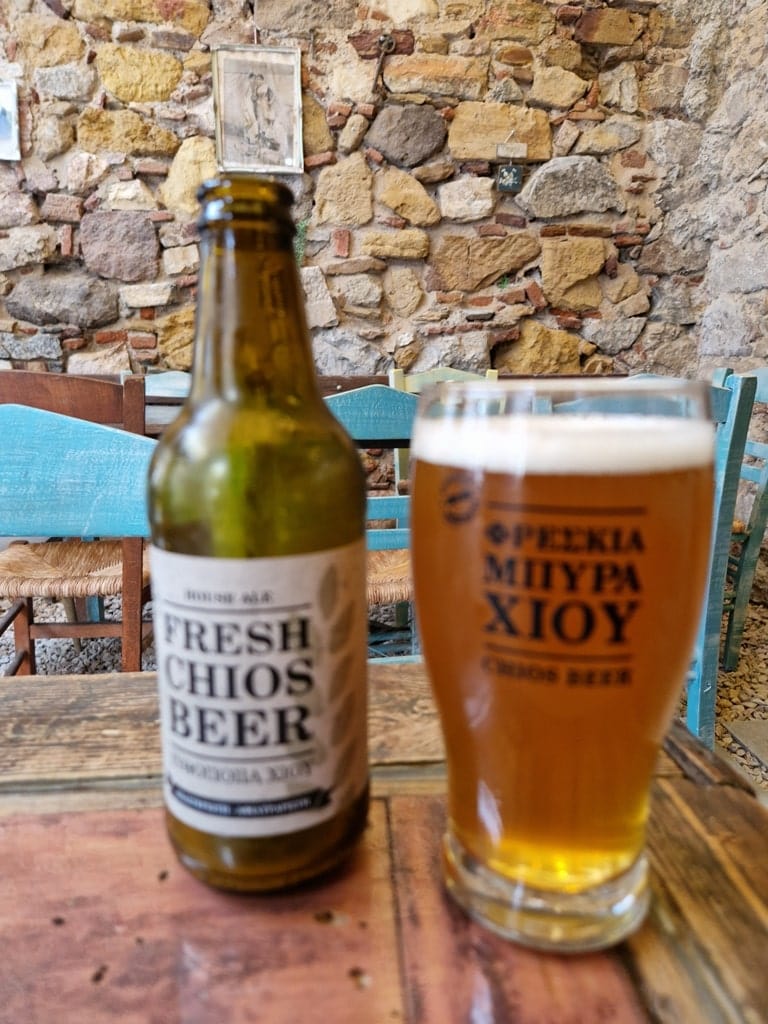
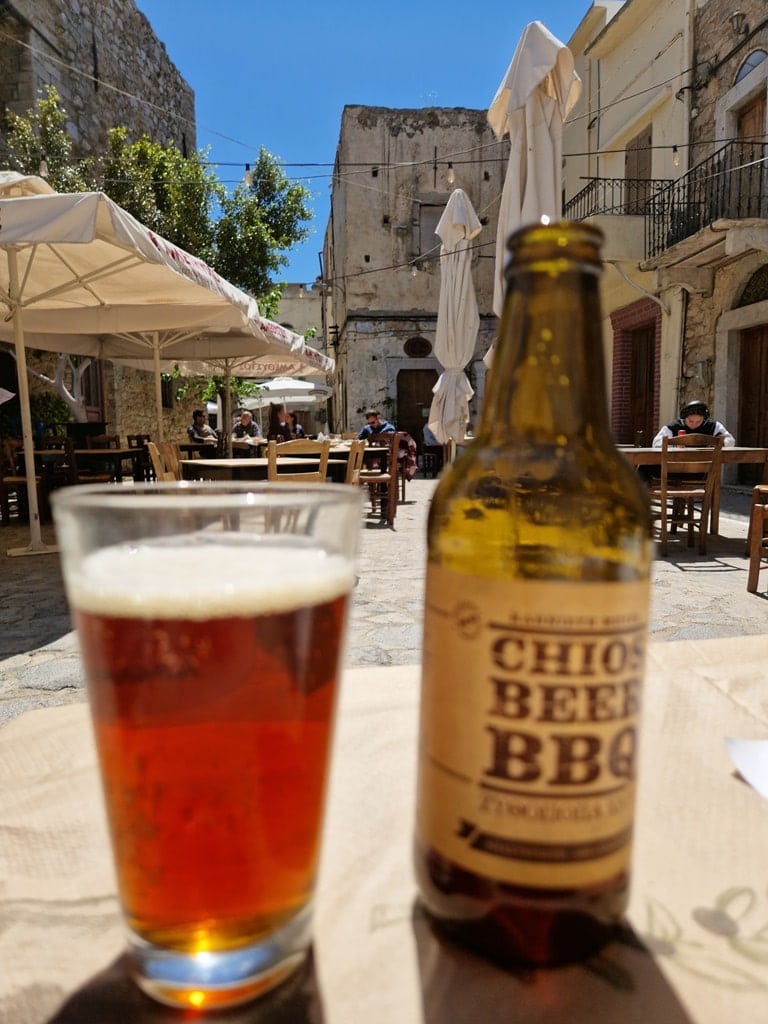
Situated in Vavilon village, Chios’ beer brewery is an experience you can’t pass up. Chios has made it in the microbrewery scene, and the Chian beer has become extremely popular within Greece and internationally.
Visit the brewery and enjoy a tour of how the beer is produced and sample beer or buy some to go!

